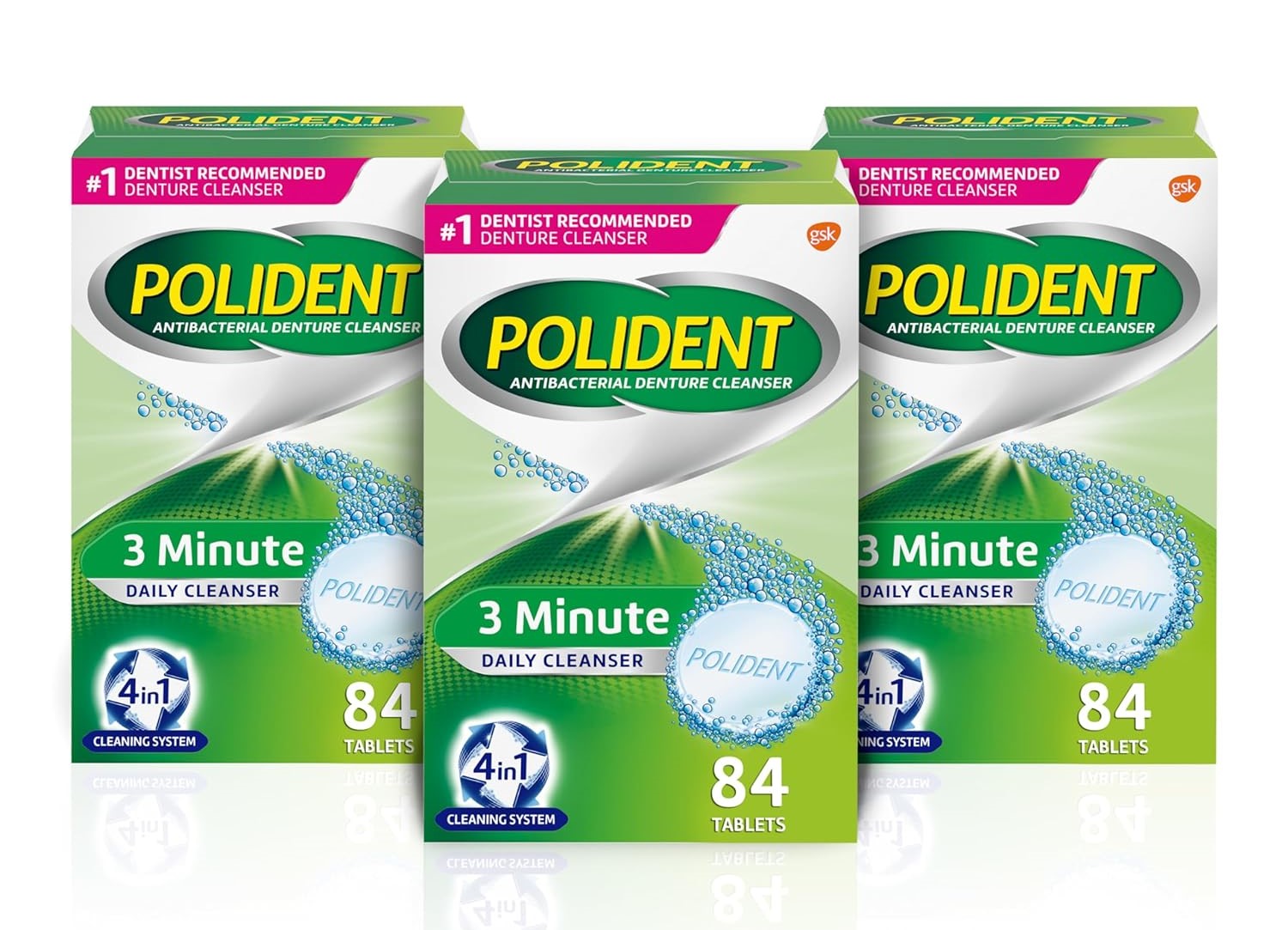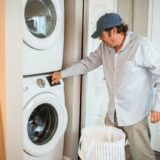These 50+ Tips Will Make Your Cleaning A Lot Easier
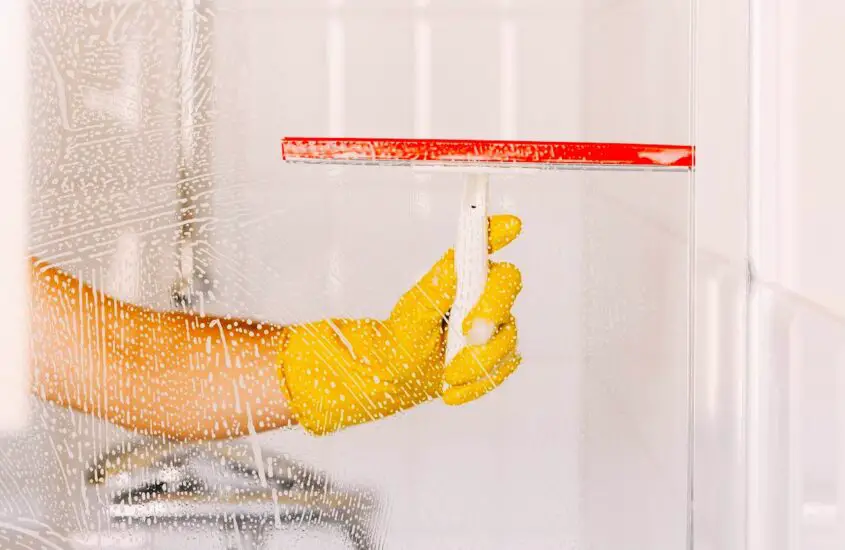
1.Start with a Plan:
Organize your cleaning tasks by room and by the level of difficulty.
Imagine stepping into a battlefield without a strategy – that’s what cleaning without a plan can feel like. The key to efficient cleaning is organization. Start by making a list of all the rooms in your home and identifying specific tasks for each.
This might include dusting in the living room, scrubbing the bathroom tiles, or organizing the pantry. Break down these tasks further into smaller, manageable chunks. For instance, in the living room, you could focus on dusting one day, vacuuming the next, and so on.
By organizing your cleaning tasks, you avoid feeling overwhelmed and ensure that nothing gets overlooked. Plus, ticking tasks off your list brings a sense of accomplishment that can be highly motivating.
View this Stackable Basket set to Organize your Home-Kitchen Pantry-Bathroom, Laundry on Amazon for $55.99 (4-Pack)
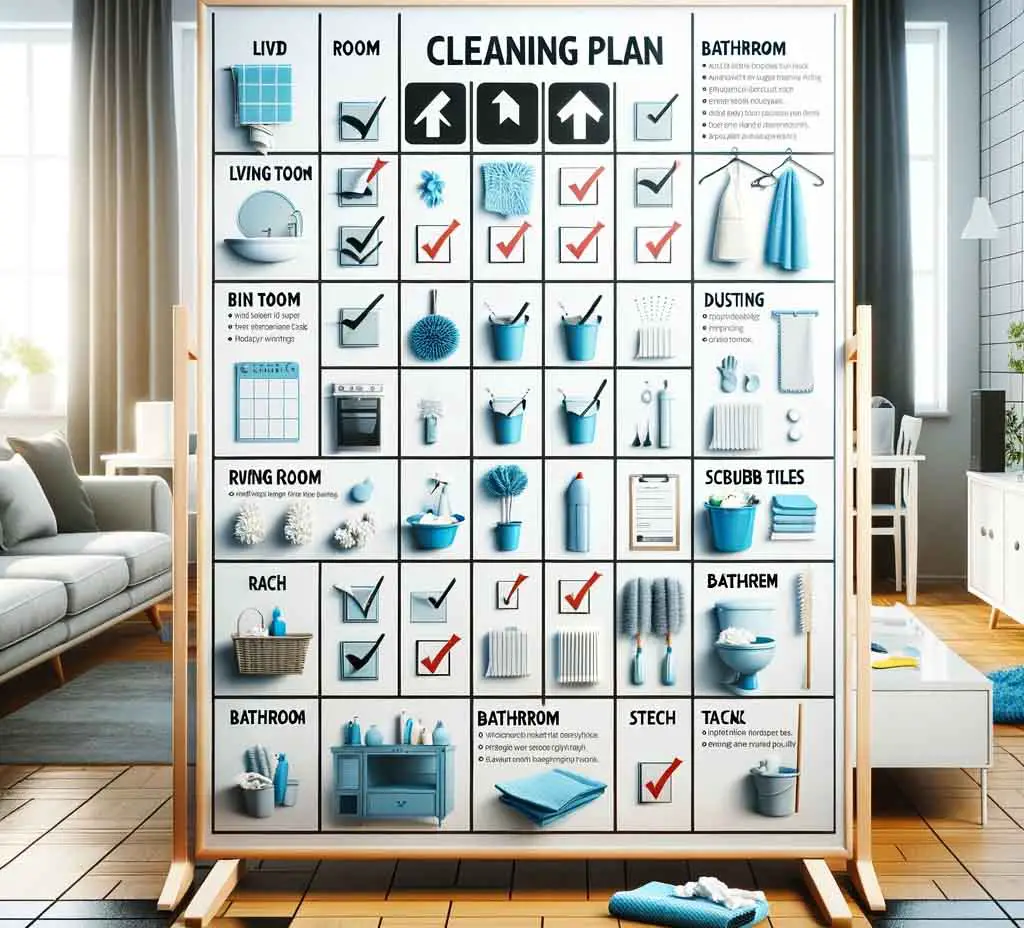
2.Declutter First:
Remove unnecessary items before you start cleaning.
Before you even think about breaking out the cleaning supplies, take a moment to declutter. Walking into a room filled with out-of-place items, old magazines, or children’s toys strewn about can make the task of cleaning seem daunting.
Start by picking up any items that don’t belong in the room and putting them in their rightful place. If you come across things you no longer need or use, consider donating or disposing of them. This initial step of decluttering not only clears physical space but also helps to declutter your mind, making the cleaning process more focused and effective.
View this storage bin for closet organizer from Amazon for $21.99 (6 packs)

3.Use Microfiber Cloths:
They are more effective and less abrasive than regular rags.
Why choose microfiber cloths over regular rags or paper towels? The answer lies in their construction. Microfiber cloths are made from tiny fibers that are much finer than a strand of silk. These fibers create a larger surface area on the cloth, allowing it to trap and hold onto dust, dirt, and even bacteria – often without the need for cleaning chemicals. This makes them an eco-friendly and efficient cleaning tool. They’re particularly useful for dusting furniture, cleaning glass surfaces without leaving streaks, and even mopping floors when attached to a flat mop head. Plus, they’re washable and reusable, saving you money in the long run.
View microfiber cloths on Amazon for $21.94 (48-Pack)
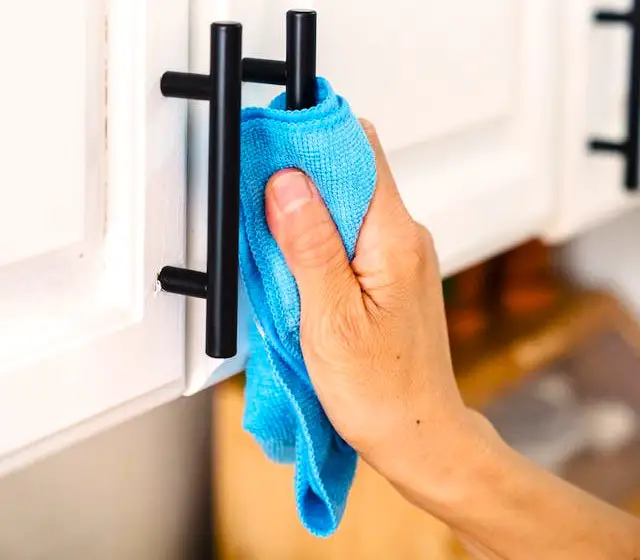
4.High to Low Cleaning:
Start from the ceiling, light fixtures, and work your way down.
This methodical approach to cleaning ensures that you don’t have to clean surfaces more than once. Start by dusting or cleaning the highest points in a room – ceiling fans, top shelves, and light fixtures. As you work your way down, dust and dirt will naturally fall to lower levels. After you’ve cleaned the higher areas, you can move on to furniture, countertops, and finally, the floors. This top-down approach is not only efficient but also prevents the frustration of finding dust resettling on freshly cleaned lower surfaces.
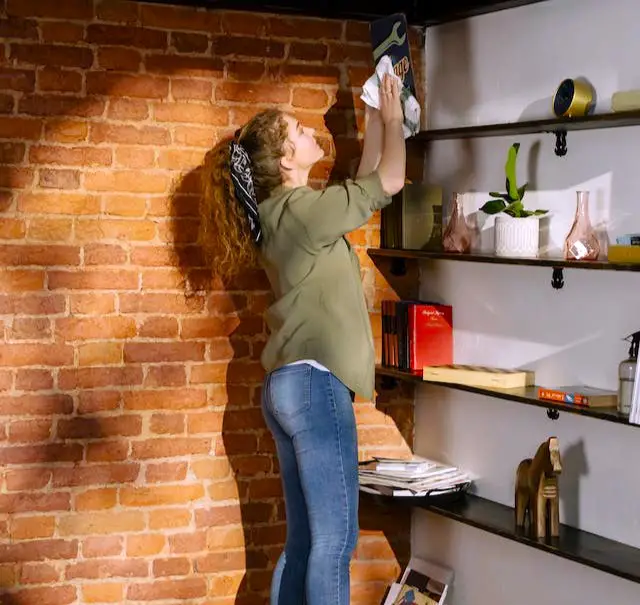
5.Baking Soda for Carpets:
Sprinkle baking soda on carpets to eliminate odors before vacuuming.
Baking soda isn’t just a kitchen staple, it’s also a powerful deodorizer for your carpets. The process is simple yet effective: sprinkle a generous amount of baking soda over the entire carpet. The baking soda works by absorbing odors and moisture deep within the carpet fibers. Let it sit for at least 15 minutes, though leaving it overnight will yield even better results, especially for stronger odors or deeper stains. Once the baking soda has had time to work its magic, vacuum your carpet thoroughly. The result? A fresher, cleaner-smelling carpet without the use of harsh chemicals.
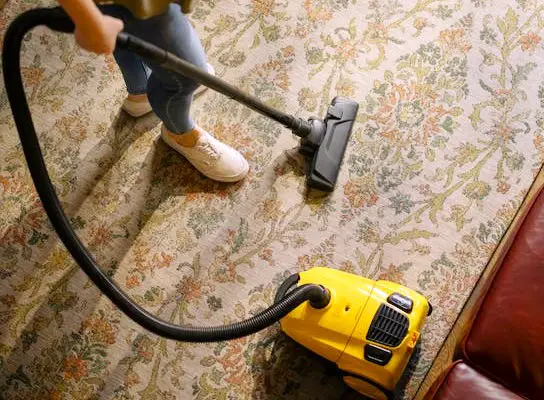
6.Vinegar for Glass:
Clean windows and mirrors with a vinegar and water solution.
Vinegar is a powerhouse when it comes to cleaning glass. Its natural acidity makes it effective at cutting through grime, grease, and fingerprints without leaving streaks. Create your own glass cleaner by mixing equal parts of white vinegar and water in a spray bottle. When you’re ready to clean, simply spray the solution onto glass surfaces such as windows, mirrors, or glass tables. Use a clean microfiber cloth or even a piece of newspaper to wipe the glass. This method is not only effective but also eco-friendly and economical. The result is a streak-free shine that brings clarity and sparkle back to your glass surfaces.
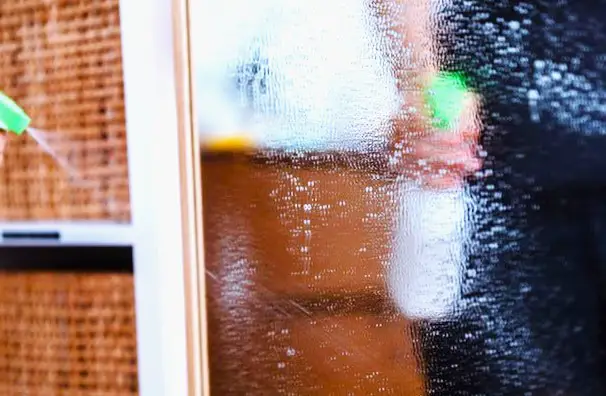
7.Lemon for Hard Water Stains:
Use lemon halves to scrub away hard water stains.
Hard water stains, with their chalky white appearance, can be an eyesore on faucets and shower doors. Here’s where the humble lemon comes to the rescue. Rich in citric acid, lemons are naturally capable of dissolving the mineral deposits that constitute hard water stains. Cut a lemon in half and directly rub it onto the stained areas. Let the juice sit for a few minutes to break down the deposits. Then, use a damp cloth to gently scrub the area. Rinse with water and dry with a clean cloth. You’ll be amazed at how the acidic power of lemon effortlessly restores the shine to your fixtures.

8.Dish Soap for Grease:
Use a drop of dish soap to tackle greasy surfaces.
Dish soap is formulated to cut through grease, making it an excellent choice for more than just dishes. Whether it’s greasy fingerprints on cabinets, stovetops, or backsplashes, a little dish soap goes a long way. Mix a few drops of dish soap with water in a spray bottle for an easy-to-use, all-purpose degreaser. Spray the solution onto the greasy surface, let it sit for a moment to break down the grease, and then wipe clean with a damp cloth. For tougher grease, you may apply dish soap directly to the area and scrub gently with a non-abrasive sponge or cloth.
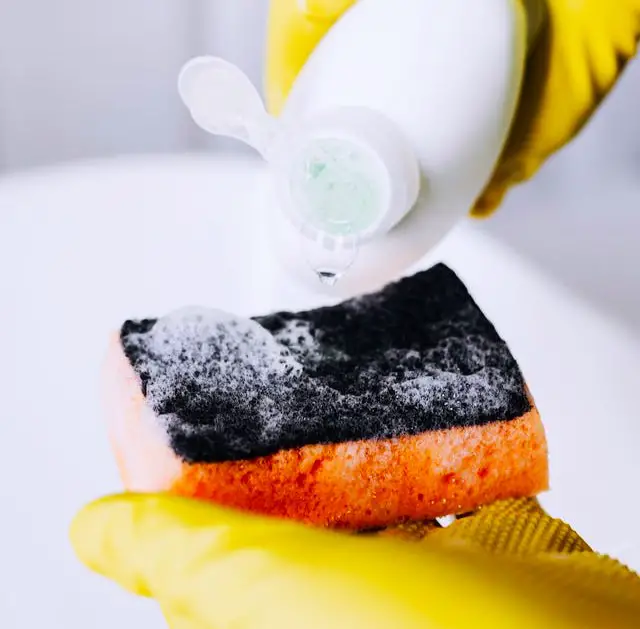
9.Use a Squeegee on Upholstery:
To remove pet hair from furniture.
Pet hair can be a persistent problem on fabric furniture, but a simple shower squeegee can provide an unexpected solution. The rubber blade of the squeegee is perfect for pulling hair out of the fabric. Glide the squeegee over the surface of your upholstered furniture, applying slight pressure. The rubber edge grips and collects the hair, which can then be easily removed by hand or vacuumed up. This method is surprisingly effective and can make a significant difference in the appearance of your furniture, leaving it looking clean and hair-free.
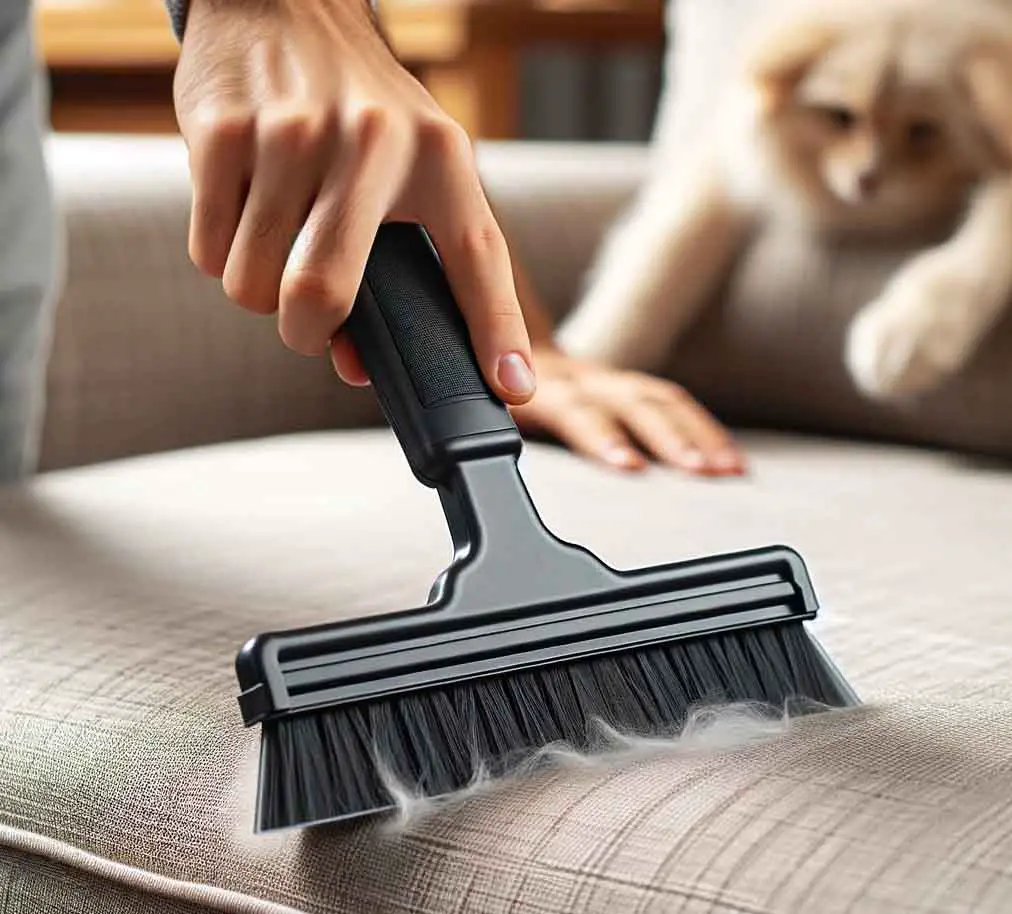
10.Rubber Gloves for Pet Hair:
Rub down upholstery with rubber gloves to gather pet hair.
Another effective tool in the fight against pet hair is a pair of ordinary rubber gloves. First, dampen the gloves slightly with water. Then, run your hands over the surfaces of your furniture, rugs, or even clothes where pet hair is a problem. The friction between the rubber and the fabric creates a static charge that helps lift and gather the hair, which sticks to the gloves. Once you’ve collected a sufficient amount of hair, simply rinse it off the gloves. This method is gentle on fabrics and can be especially useful for cleaning pet hair from more delicate items.
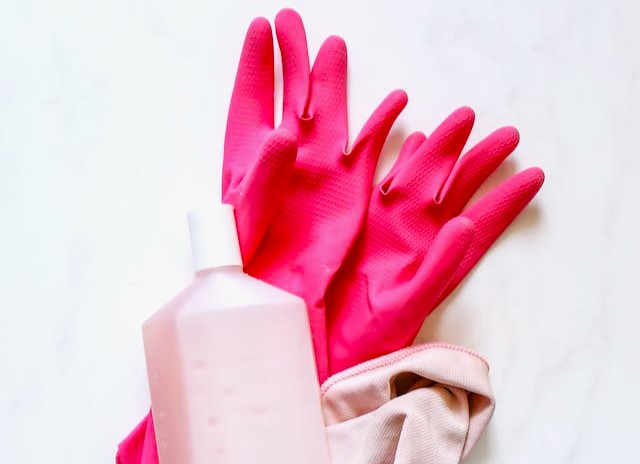
11.Salt for Spills on Carpet:
Salt can absorb fresh stains before they set.
Spills on carpets can quickly turn into stubborn stains if not addressed promptly. In such moments, table salt is an incredibly effective and readily available solution. Its absorbing properties are particularly suited for soaking up fresh spills. When a spill occurs, generously sprinkle table salt over the wet area. The salt works by absorbing the liquid, thereby preventing it from seeping deeper into the carpet fibers. Allow the salt to sit for a few minutes – longer for larger spills – and then vacuum it up. This method is especially effective for red wine or dark-colored liquids, helping to lift them off the carpet and minimize staining.
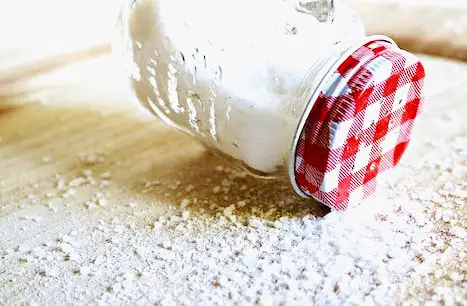
12.Toothbrush for Small Spaces:
Clean hard-to-reach areas with an old toothbrush.
An old toothbrush is a surprisingly powerful cleaning tool for small, hard-to-reach areas. Its small head and bristles are perfect for dislodging dirt and grime in tight spaces where larger cleaning tools can’t reach. Use it to scrub around faucet handles, in tile grout, along window tracks, or in any other narrow space where dirt tends to accumulate. For an enhanced effect, dip the toothbrush in a cleaning solution suitable for the surface you’re working on. The bristles work into tiny crevices, providing a thorough clean that’s difficult to achieve with larger tools.

13.Baking Soda and Vinegar for Drains:
Unclog drains with a baking soda and vinegar mix.
The combination of baking soda and vinegar is a powerful, natural cleaning solution for keeping your drains clear and odor-free. Start by pouring a half cup of baking soda directly down the drain. Follow this with a half cup of white vinegar. The mixture will fizz and bubble – a reaction that helps to break down grime and buildup in the drain. Let it sit for about 10 minutes, then flush the drain with hot water. This eco-friendly method is excellent for routine drain maintenance and can help prevent clogs before they become a problem.
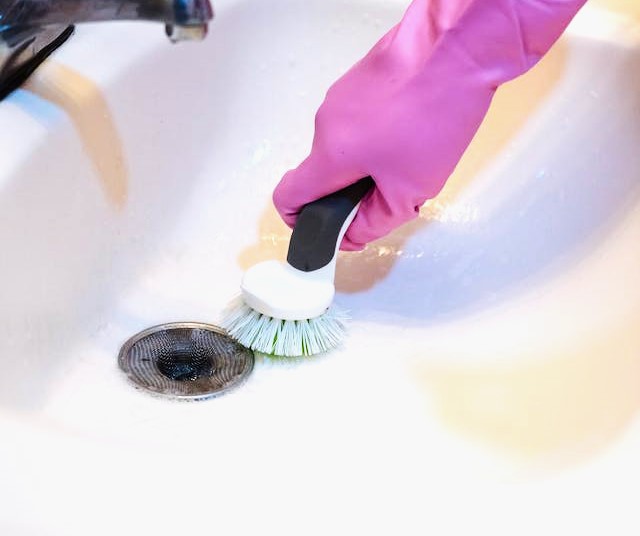
14.Olive Oil for Stainless Steel:
Polish stainless steel appliances with a small amount of olive oil.
Olive oil isn’t just for cooking – it’s also a fantastic polish for stainless steel appliances. To bring back the shine to your stainless steel, put a few drops of olive oil on a soft cloth and gently rub it into the surface. This will help to remove streaks, fingerprints, and smudges, leaving your appliances looking shiny and new. Olive oil also leaves a protective layer that can help repel future marks, keeping your stainless steel cleaner for longer.
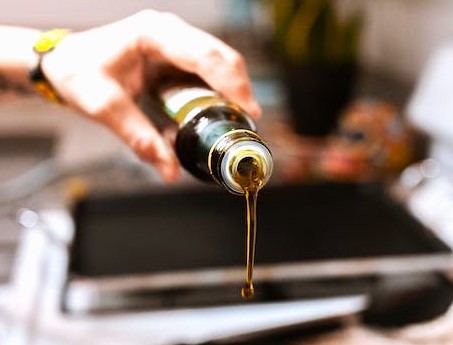
15.Coffee Filters for Screens:
Clean TV and computer screens with a coffee filter to reduce lint.
Cleaning delicate screens, such as those on TVs and computers, requires a gentle touch to avoid scratches and damage. Coffee filters are an excellent tool for this task. Their soft, lint-free texture makes them ideal for wiping away dust and fingerprints without leaving behind any residue. Gently wipe the filter over the screen in a circular motion, applying minimal pressure. This method is not only effective but also very affordable, making it a great alternative to more expensive screen-cleaning solutions.
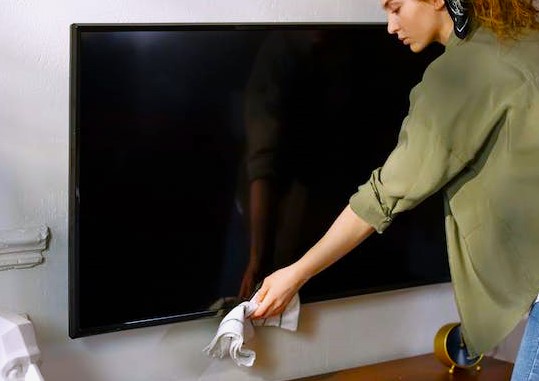
16.Ice Cubes for Garbage Disposal:
Run ice cubes through the disposal to sharpen the blades and remove odors.
A simple yet effective method to clean and sharpen the blades of your garbage disposal is to use ice cubes. Simply toss a handful of ice cubes into the disposal and run it. The ice helps to dislodge any food particles or residue clinging to the blades. As the ice cubes are crushed and spun around, they act like a scrubbing agent inside the disposal unit. For an added bonus, add some rock salt to the ice. The coarseness of the salt adds extra abrasiveness. This process not only cleans your disposal but also sharpens the blades, ensuring it runs more efficiently. To leave a fresh scent and tackle any lingering odors, follow up with a few lemon peels or a bit of lemon juice.
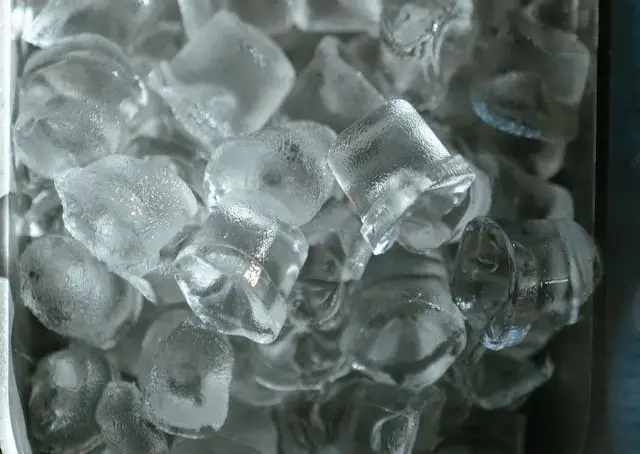
17.Dryer Sheets for Baseboards:
Clean and reduce static on baseboards with dryer sheets.
Cleaning baseboards can be a tedious task, but dryer sheets offer a simple and effective solution. Not only do they pick up dust and hair with ease, but they also leave behind a thin layer that helps repel these particles in the future. Take a fresh dryer sheet and gently run it along your baseboards. The antistatic properties in the sheet will help lift the dust, and the slight coating it leaves will reduce the amount of dust that sticks to the baseboards going forward. This method is particularly useful in homes with pets, as it helps gather pet hair and dander that often accumulate along baseboards.
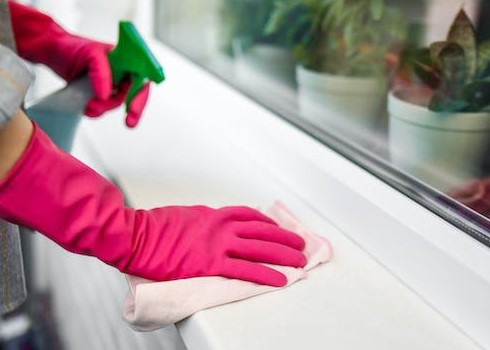
18.Steam Clean Microwave:
Heat a bowl of water with lemon inside the microwave before wiping.
Cleaning a microwave can be challenging, especially with hardened food residues. To easily loosen this grime, fill a microwave-safe bowl with water and add a few slices of lemon. Microwave this on high for several minutes until the inside of the microwave is steamy and the water is boiling. Let it stand for a few minutes to allow the steam to loosen the grime. Then, carefully remove the bowl and wipe the inside of the microwave with a damp cloth. The steam softens the residues, and the lemon helps to remove odors, leaving your microwave clean and fresh.
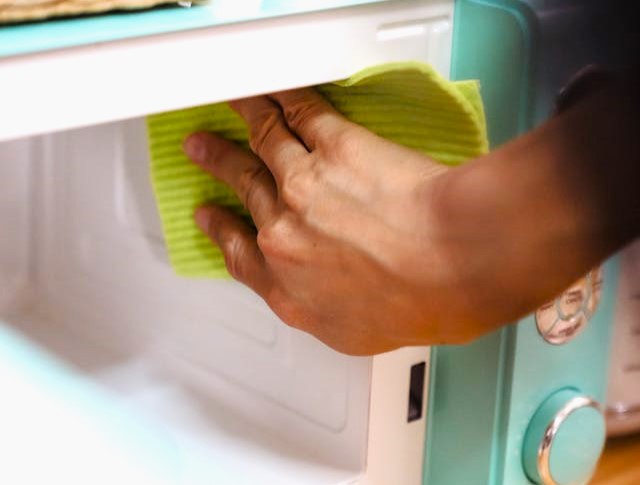
19.Denture Tablets for Toilet Stains:
Drop a couple of denture cleaning tablets into the toilet bowl to remove stains.
Denture cleaning tablets are an unconventional but effective cleaning agent for your toilet. These tablets are designed to remove stains and bacteria, making them perfect for tackling toilet bowl stains. Drop a couple of denture tablets into the toilet bowl and let them fizz and dissolve for about half an hour. The effervescent action helps to break down stains and mineral deposits. After the tablets have fully dissolved, give the bowl a good scrub with a toilet brush and flush. This method is especially useful for removing hard water stains and leaving your toilet sparkling clean.
20.Wax Paper for Faucets:
Rub faucets with wax paper to prevent water spots and fingerprints.
Water spots and fingerprints on faucets can make even a clean bathroom or kitchen look unkempt. To combat this, grab a piece of wax paper from the kitchen. After cleaning your faucets, rub them down with the wax paper. This creates a thin protective layer on the metal that repels water and prevents fingerprints. The result is a longer-lasting shine and less frequent cleaning of your faucets. This trick can be used on any chrome or stainless steel fixtures to keep them looking shiny and new.
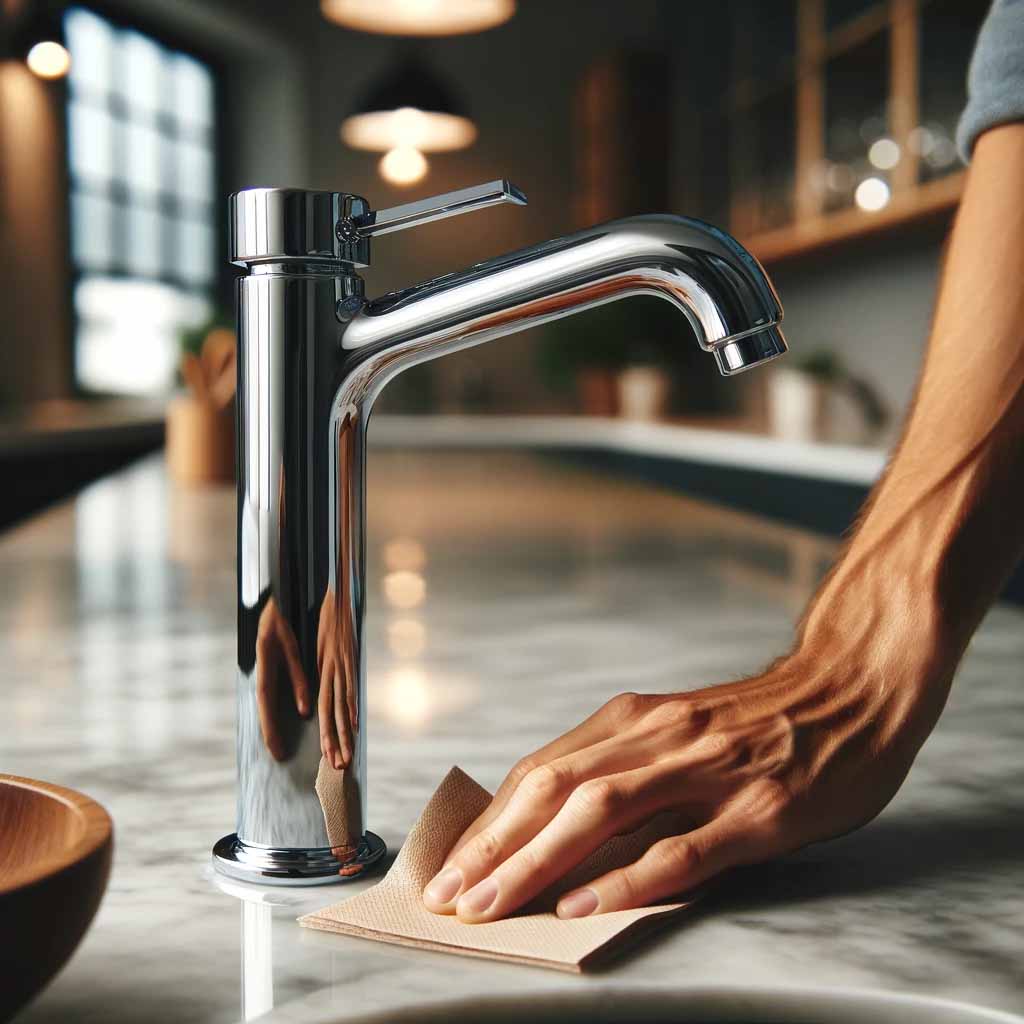
21.Chalk for Grease Stains:
Rub chalk on a grease stain before laundering.
Chalk is an excellent tool for tackling grease stains on clothing. The absorbent nature of chalk makes it ideal for soaking up oils and greases. To use this method, simply rub a piece of white chalk over a grease stain as soon as possible after the stain occurs. The chalk powder will absorb some of the oil, reducing the stain. Let the chalk sit on the stain for about 10 minutes, then brush it off gently. After removing the chalk, launder the item as usual. This method works best on fresh stains and can save your clothes from permanent grease marks.
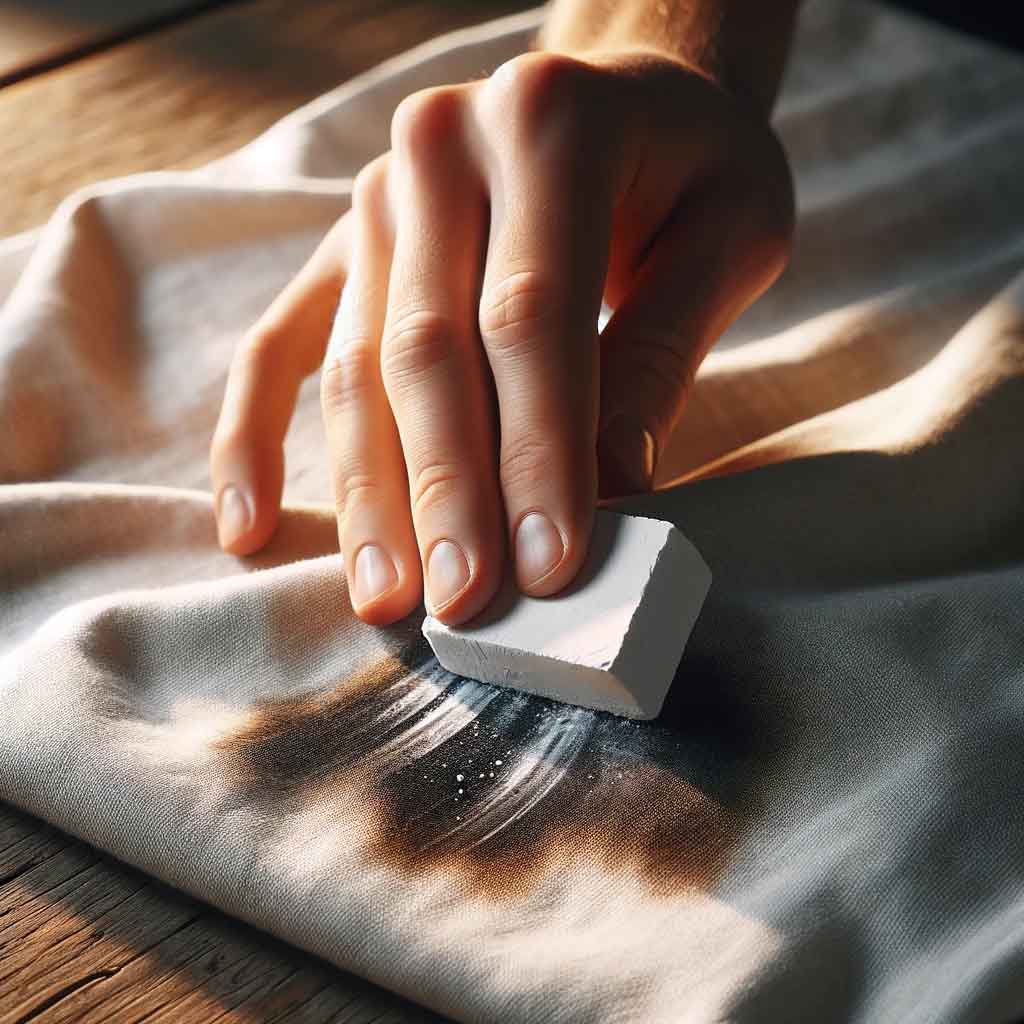
22.Use a Lint Roller on Lampshades:
Quickly clean lampshades with a lint roller.
Cleaning lampshades can be tricky due to their delicate materials and awkward shapes. A lint roller offers a simple and effective solution. Roll it over the fabric of the lampshade to quickly and gently remove dust, lint, and pet hair. This method is particularly useful for pleated or textured shades where dust tends to accumulate and is hard to remove with a cloth. The sticky surface of the lint roller picks up the dust without damaging the shade, making your lampshades look clean and refreshed with minimal effort.
Buy Lint Roller from Amazon for $19.99 (5-Pack)

23.Alcohol for Stainless Steel:
Use rubbing alcohol to clean and shine stainless steel.
Rubbing alcohol is a surprisingly effective cleaner for stainless steel surfaces. It not only cleans but also disinfects and leaves a streak-free shine. To use, apply a small amount of rubbing alcohol to a soft, lint-free cloth. Gently wipe the stainless steel surface, going with the grain to avoid scratches. The alcohol will quickly evaporate, leaving the surface shiny and clean. This method is great for kitchen appliances, sinks, and faucets, and it also removes fingerprints and water spots.
here is a Stainless Steel Cleaner and Polish For Appliances from Amazon for $36 (3- Pack)
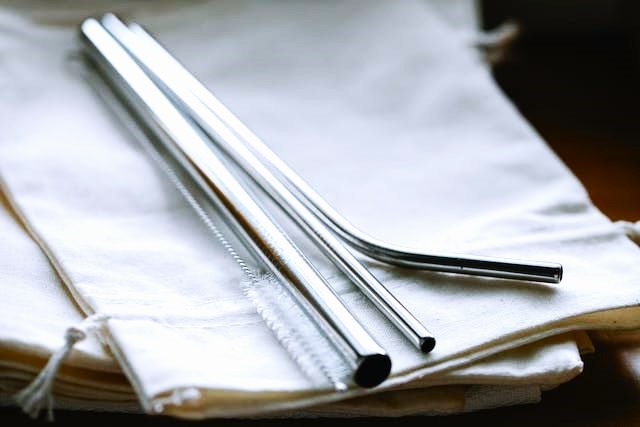
24.Cornstarch for Window Blinds:
Dust with cornstarch for a quick clean.
Cornstarch can be a handy cleaning agent for dusty window blinds. Its fine, powdery texture makes it great for picking up and holding onto dust. To use this method, close your blinds and sprinkle cornstarch over them. Then, using a clean paintbrush or microfiber cloth, gently brush over the blinds. The cornstarch will cling to the dust, making it easier to collect and remove. Once you’ve brushed off the cornstarch, open the blinds and wipe down any remaining residue with a damp cloth. This method is particularly effective for fabric and vinyl blinds.
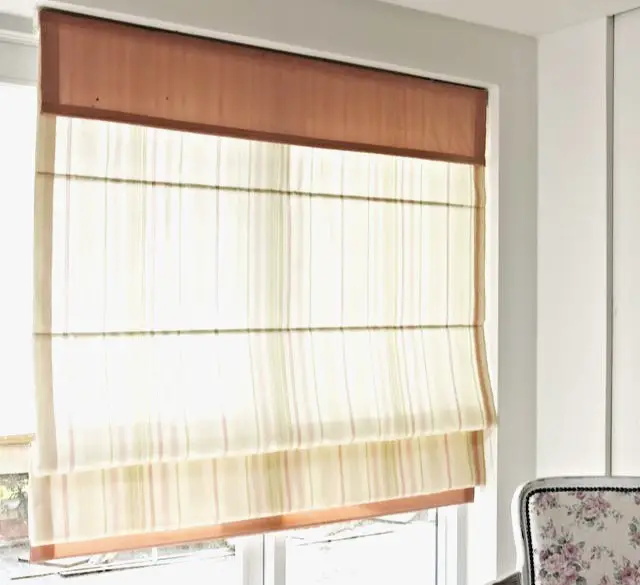
25.Hair Dryer for Water Rings:
Gently blow dry water rings on wooden furniture.
Water rings on wooden furniture can be unsightly, but a common hair dryer can help remove them. Turn your hair dryer to a low heat setting and hold it a few inches away from the water ring. Slowly move the dryer over the affected area, allowing the warm air to penetrate the wood. The heat helps to evaporate the moisture trapped in the wood, gradually fading the water ring. Be patient and avoid using high heat, as this can damage the wood finish. After the ring has disappeared, apply a little furniture polish to the area to protect the wood.
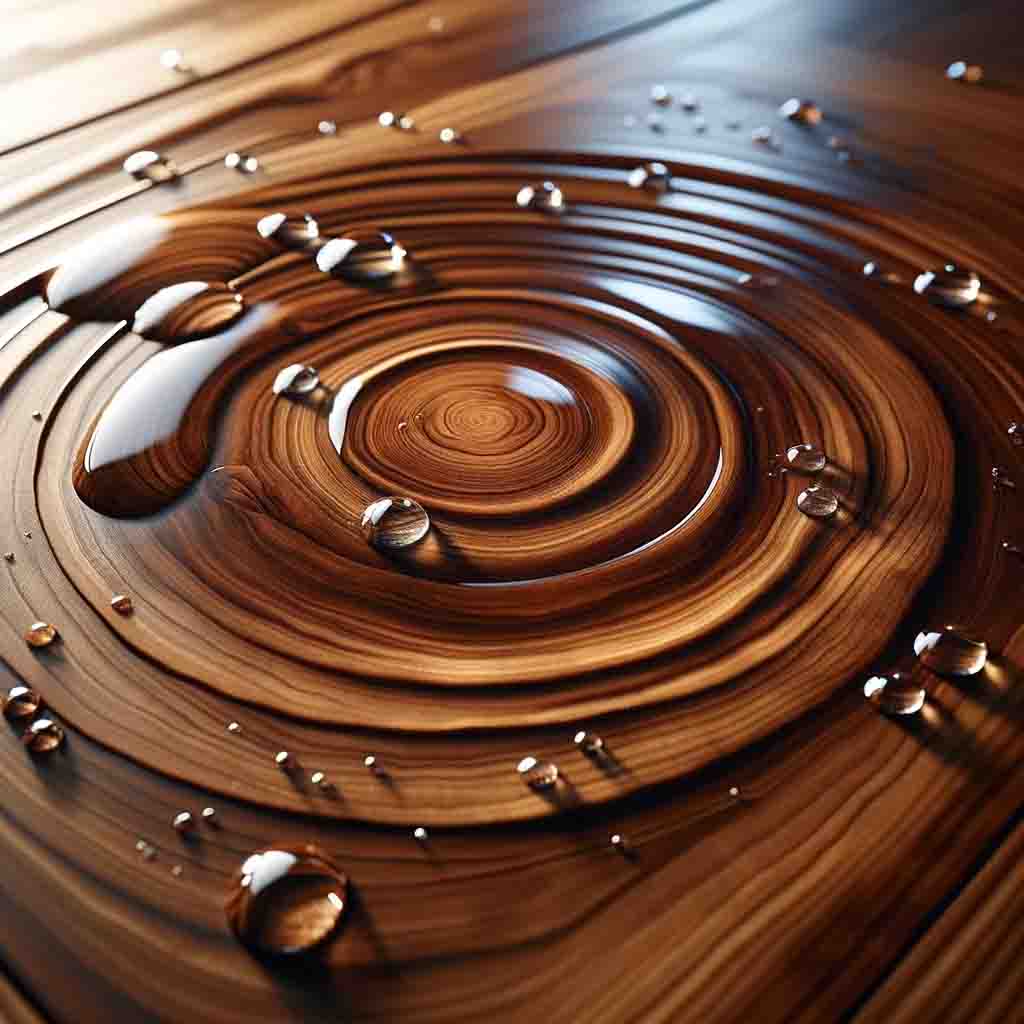
26.Ketchup for Copper:
Polish copper pots and pans with ketchup.
Ketchup, with its acidic nature, is surprisingly effective at cleaning and shining copper pots and pans. The natural acidity of tomatoes in the ketchup helps to dissolve tarnish and restore the copper’s shine. Apply a thin layer of ketchup to the copper surface and let it sit for a few minutes. The acids will gently react with the tarnish. Then, using a soft cloth or sponge, rub the ketchup into the copper in a circular motion. Rinse thoroughly with warm water and dry immediately to reveal a bright, polished finish. This method is safe and effective for occasional use on copper items that have lost their luster.
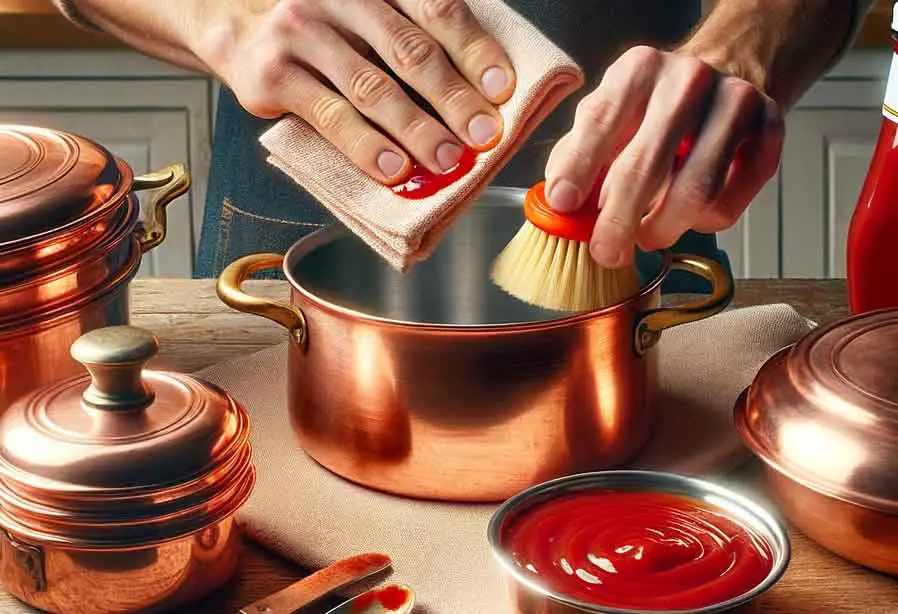
27.Hydrogen Peroxide for Grout:
Clean grout lines with hydrogen peroxide.
Over time, grout between tiles can become discolored and dirty. Hydrogen peroxide is an excellent natural cleaner for brightening and disinfecting grout. Simply mix hydrogen peroxide with an equal part of water in a spray bottle. Spray this solution directly onto the grout lines and let it sit for several minutes. The hydrogen peroxide works to break down the dirt and stains, making them easier to scrub away. After letting it sit, scrub the grout with a stiff-bristled brush, then rinse with water. This method will leave your grout looking brighter and cleaner.
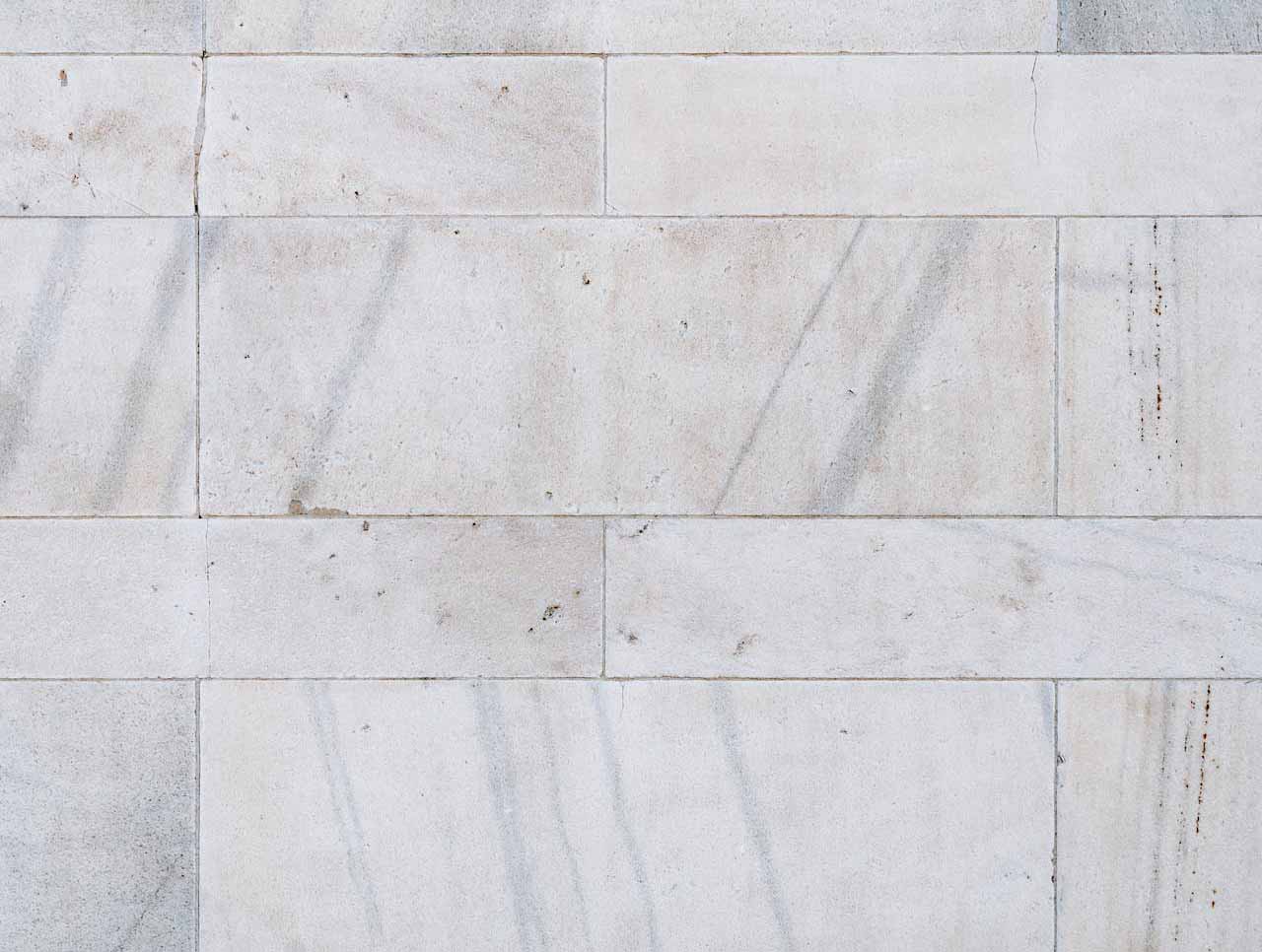
28.Walnut for Wood Scratches:
Rub a walnut over minor scratches in wood.
Minor scratches on wood furniture can be visibly reduced using a walnut. Walnuts contain natural oils that help to darken the exposed wood and blend the scratch into the surrounding area. Rub a walnut kernel over the scratch in the wood, going back and forth several times. The oils from the walnut seep into the wood, helping to heal the scratch. After rubbing, let the oil sit for a few minutes, then buff the area with a soft cloth. This natural method is particularly effective on small, superficial scratches in darker wood.
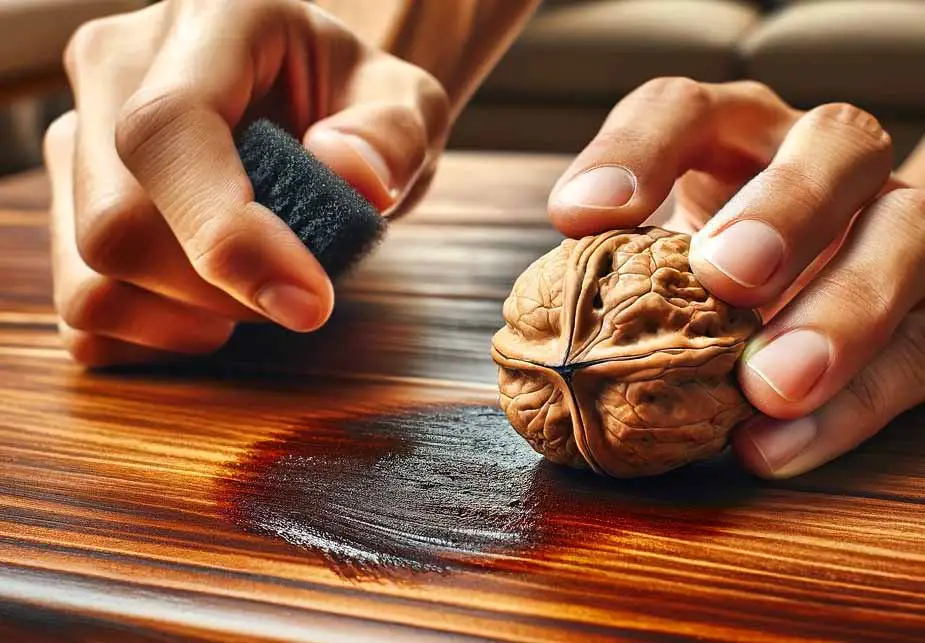
29.Sock for Dusting:
Use an old sock as a dusting mitt.
An old sock can be repurposed into an effective dusting tool, especially for reaching into tight spaces or for dusting irregularly shaped objects. Slip the sock onto your hand and use it as a flexible duster. Your fingers can get into spaces where a traditional duster might not reach, like between slats in window blinds or around intricate decorations. For added dusting power, slightly dampen the sock or apply a bit of dusting spray to it. When you’re done, simply wash the sock and it’s ready for next time.
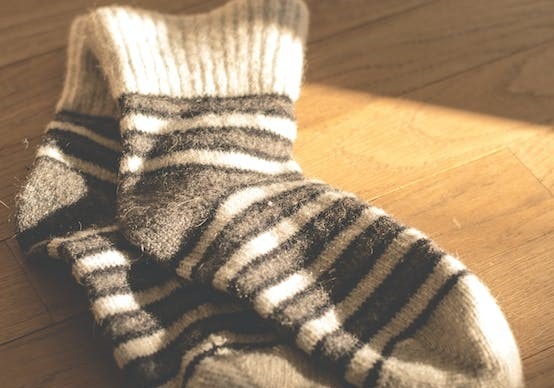
30.White Bread for Wall Marks:
Dab at wall marks with a piece of white bread.
Believe it or not, a piece of white bread can be used to gently remove marks from walls. White bread has a soft, spongy texture that acts like a natural eraser. Take a slice of plain white bread and gently rub it over the mark on the wall. The bread will pick up and absorb the dirt or crayon marks without damaging the paint. This method is especially useful for removing fingerprints or smudges from matte or flat-painted walls where traditional cleaners might leave streaks.
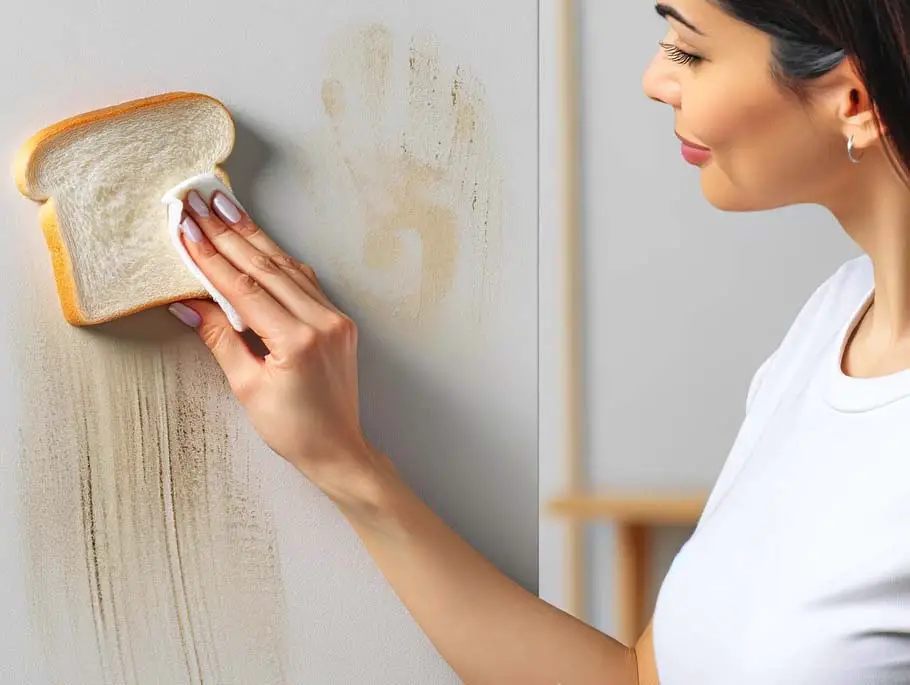
31.Rice for Coffee Grinders:
Clean a coffee grinder by grinding rice.
Coffee grinders can accumulate oils and residue from coffee beans, affecting the flavor of your brew. Uncooked rice can be used as a natural abrasive to clean and freshen up your coffee grinder. Simply add a handful of uncooked white rice to the grinder and run it for a minute. The rice grains will scrub the blades and interior, absorbing oils and residue. Once done, discard the rice and wipe the grinder clean. This method is quick, effective, and ensures your coffee grinder remains in optimal condition for a fresh-tasting coffee every time.
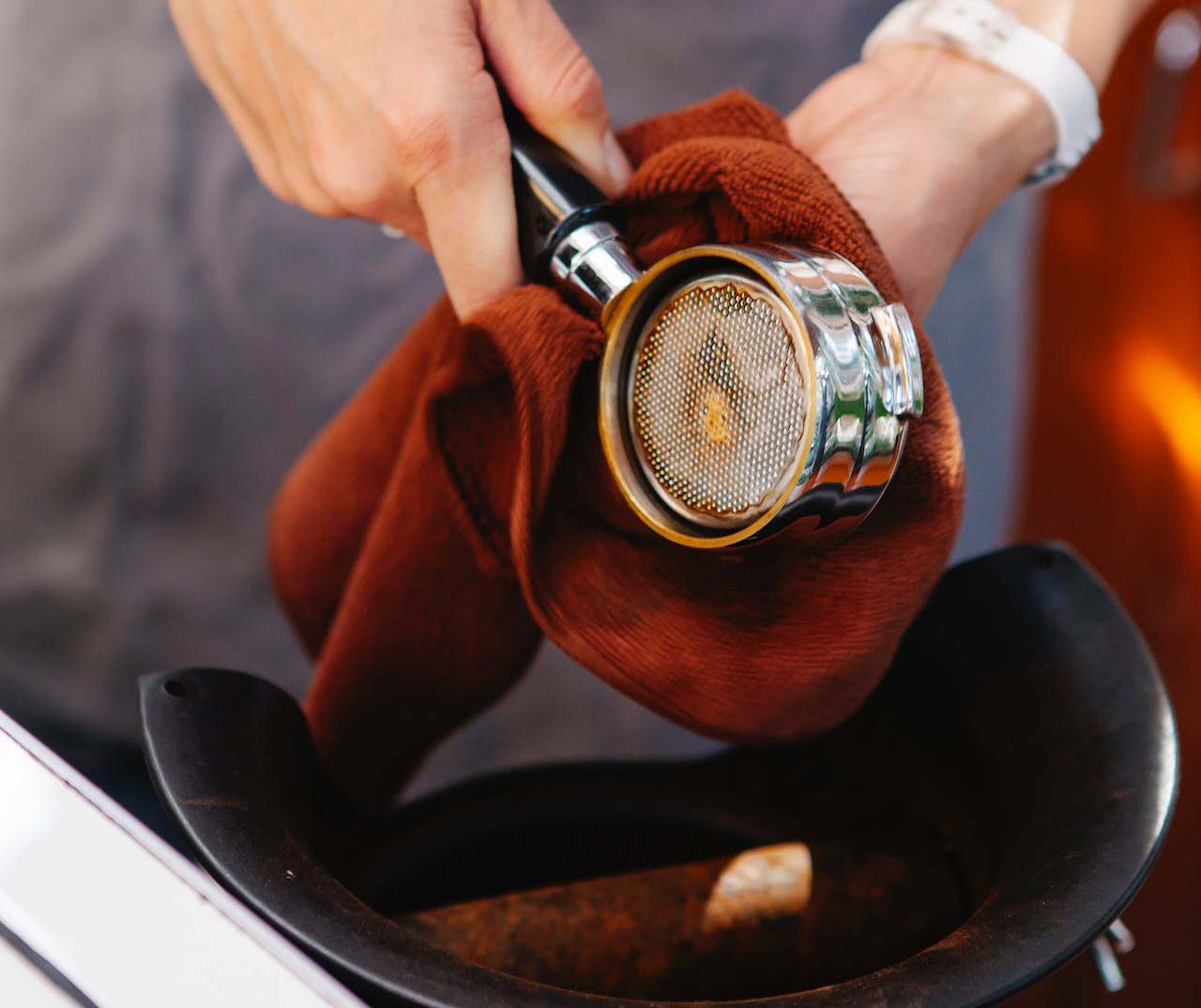
32.Vanilla Extract for Fridge Odors:
Wipe the fridge with vanilla extract for a fresh scent.
Combat refrigerator odors with a touch of vanilla extract. Soak a few cotton balls in vanilla extract and place them in a small dish in your refrigerator. The vanilla acts as a natural deodorizer, absorbing and neutralizing unpleasant smells. This method leaves a gentle, pleasant aroma without overpowering the natural scent of your food. It’s a simple and natural way to keep your fridge smelling fresh.
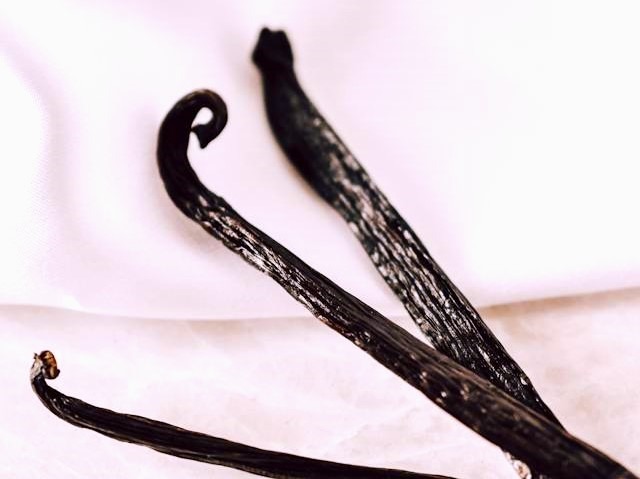
33.Cola for Toilet Bowl:
Pour cola in the toilet bowl to remove stains.
The acidic nature of cola makes it an unconventional yet effective cleaning agent for toilet bowls. Pour a can of cola into the toilet bowl and let it sit for an hour. The acids in the cola work to break down stains and mineral deposits. After an hour, scrub the bowl with a toilet brush and flush. This method can help tackle tough stains and leave your toilet sparkling clean, plus it’s a great way to use up any flat or leftover cola.

34.Tennis Ball for Scuff Marks:
Rub scuff marks with a tennis ball.
Scuff marks on floors and walls can be stubborn to remove. A simple tennis ball can be your solution. The rubbery texture of the tennis ball is abrasive enough to remove scuff marks without damaging the surface. Cut a small X into the ball and stick it onto the end of a broom or mop handle. Rub the tennis ball over the scuff marks using gentle pressure. The marks will gradually lift away, leaving your surfaces looking clean and refreshed.
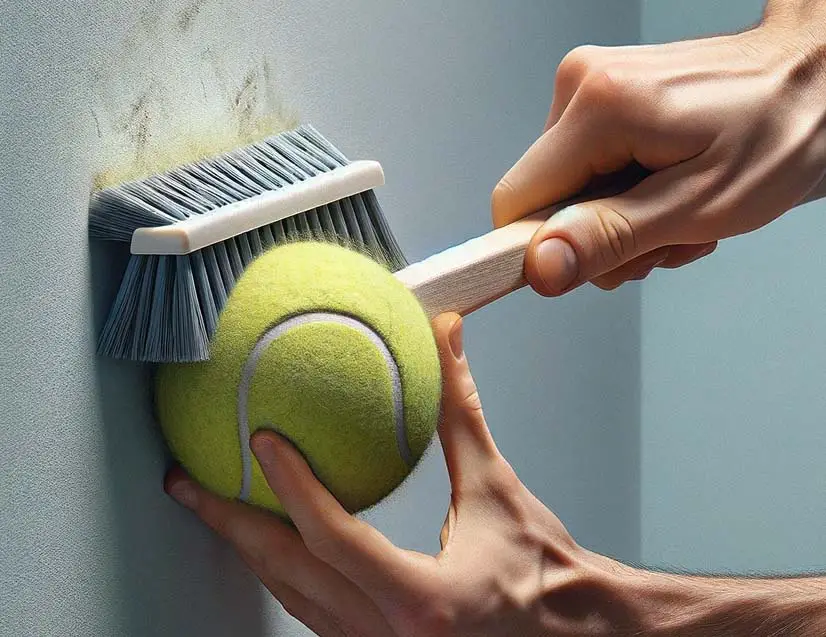
35.Dryer Sheet in Air Vents:
Place a dryer sheet in air vents for a fresh scent.
Placing a dryer sheet in your home’s air vents can spread a fresh scent throughout the room. Simply attach a dryer sheet to the vent with a bit of tape. When the air blows through, it will carry the fresh scent of the dryer sheet with it, subtly perfuming the room. This method is a simple way to freshen up your living space and works especially well in small rooms or areas where you want a consistent, pleasant aroma.

36.Alka-Seltzer for Vases:
Clean narrow vases with Alka-Seltzer tablets.
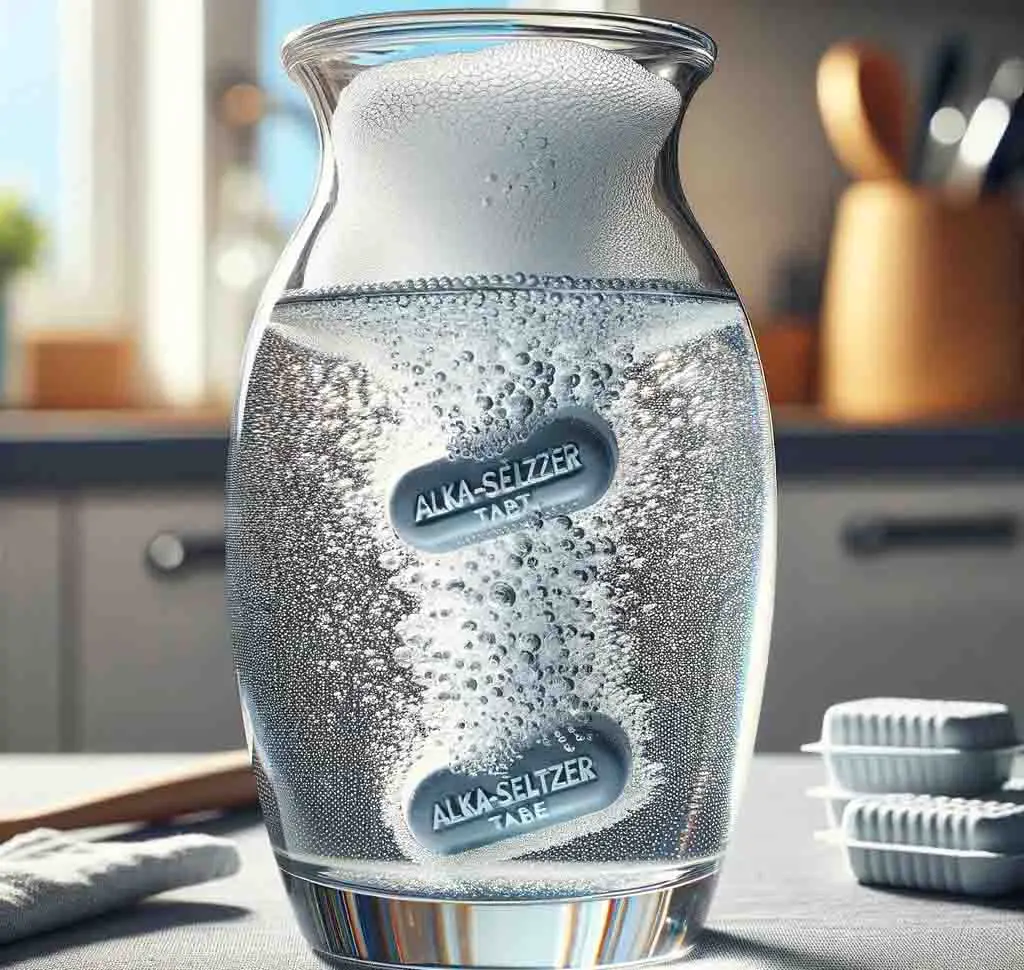
Cleaning narrow-necked vases can be challenging, but Alka-Seltzer tablets offer a simple solution. The effervescent action of Alka-Seltzer helps to loosen and dissolve dirt and grime inside the vase. Fill the vase with water and drop in two Alka-Seltzer tablets. Let the solution fizz for several minutes. The bubbling action will reach into the crevices and help lift any residue or build-up. After the fizzing has stopped, give the vase a good rinse with clean water. This method is particularly effective for removing hard water stains and leaving your vases sparkling clean.
37.Baby Oil for Chrome:
Shine chrome fixtures with a little baby oil.
Baby oil is not just for skincare; it’s also great for polishing chrome fixtures. After cleaning your chrome surfaces, apply a small amount of baby oil to a soft cloth. Gently rub the cloth over the chrome to add shine and remove any remaining water spots. The oil leaves a protective sheen, making the chrome look polished and new. This method works well on faucets, showerheads, and other chrome bathroom or kitchen fixtures, adding a lustrous finish that enhances the overall look of the space.
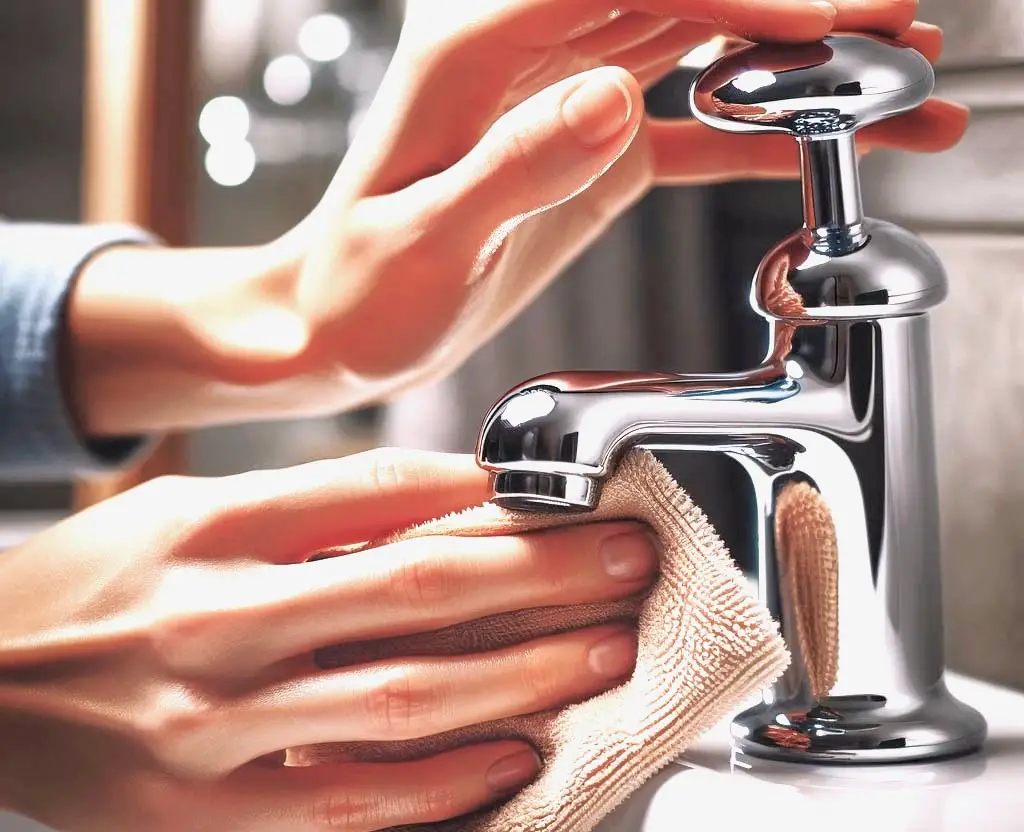
38.Tape for Crumbs:
Pick up crumbs and debris with the sticky side of tape.
Picking up crumbs and small debris from tables and countertops can be done efficiently with a simple piece of tape. Wrap a piece of wide, sticky tape, like packing tape, around your hand with the sticky side out. Gently pat the tape over the surface where the crumbs are scattered. The crumbs will stick to the tape, making clean-up quick and easy. This method is particularly useful for cleaning up after meals or snacks, especially when dealing with bread crumbs or pastry flakes that can be tedious to wipe up with a cloth.
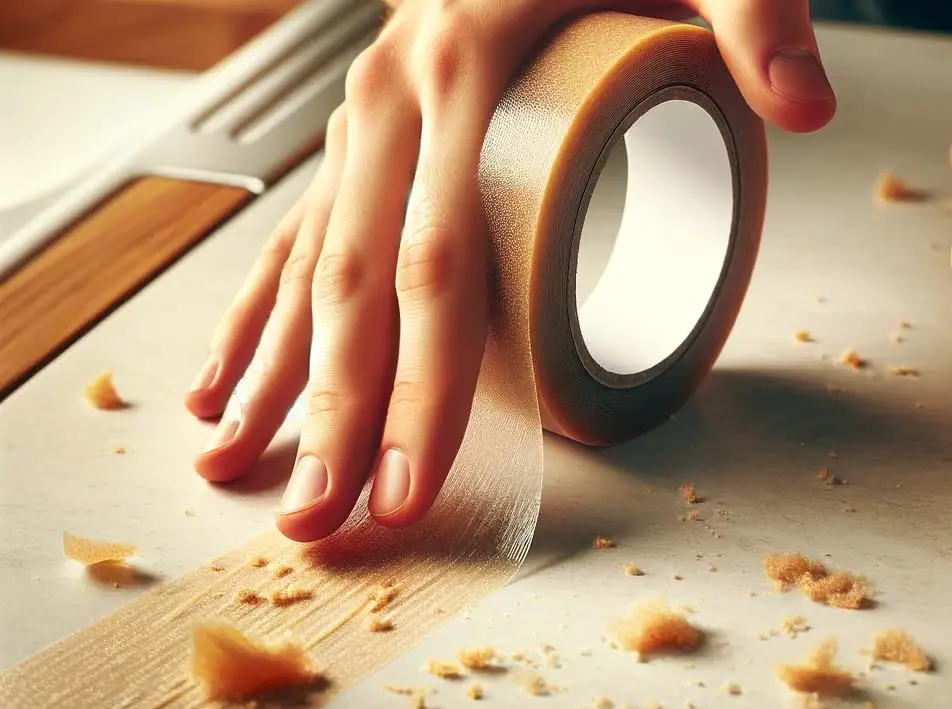
39.Boiling Water for Drains:
Regularly pour boiling water down drains to keep them clear.
Regularly flushing your drains with boiling water can help keep them clear and free of odor-causing build-up. Simply boil a kettle of water and carefully pour it down the drain. The high temperature of the water helps to dissolve and dislodge grease, soap scum, and other residues that may be lining the pipes. This preventative maintenance can help avoid clogs and keep your drains flowing smoothly. It’s a simple, chemical-free way to maintain your drains on a weekly basis.
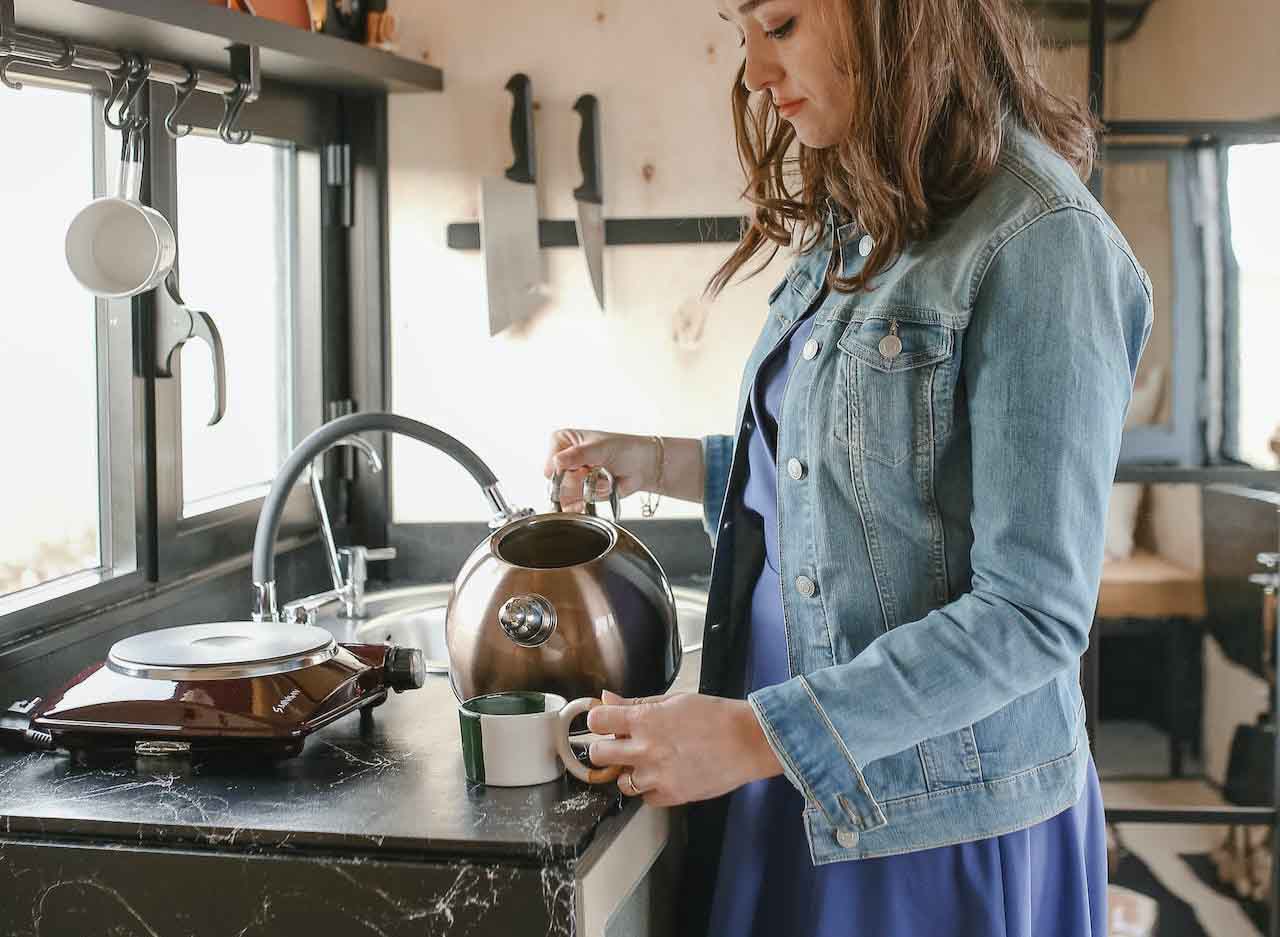
40.Plastic Knife for Tight Spaces:
Use a plastic knife to clean out crevices.
A plastic knife can be a handy tool for cleaning tight spaces where a cloth can’t reach. Use the edge of a plastic knife to scrape out dirt and grime from crevices in appliances, around the edges of countertops, or in other narrow spaces. The knife is rigid enough to dislodge dirt but soft enough not to scratch surfaces. After loosening the dirt, you can use a vacuum with a crevice tool or a damp cloth to clean up the residue. This method is particularly effective for cleaning around the stove, where food particles tend to accumulate in narrow gaps.
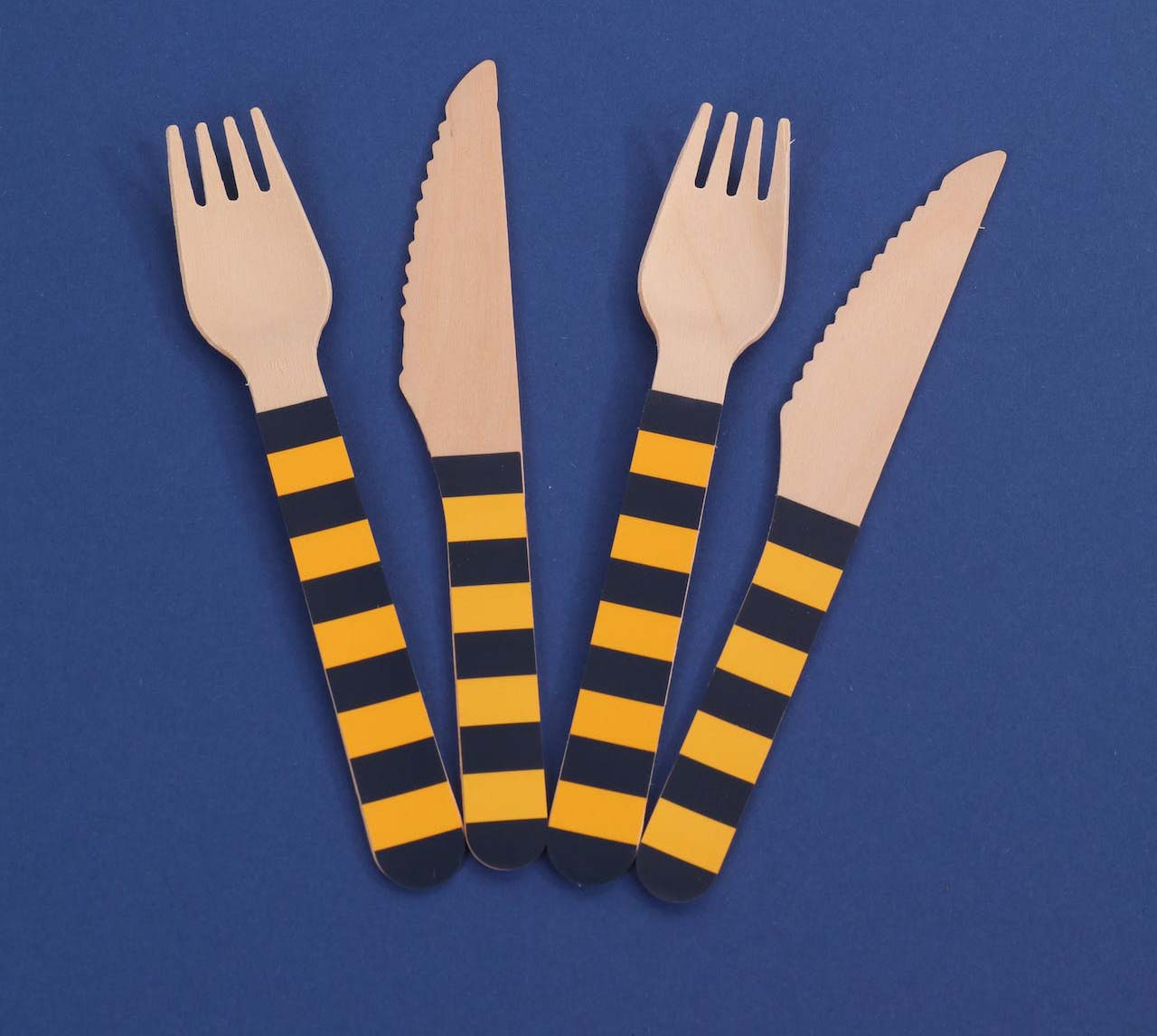
41.Bread Bag Clip for Tape:
Use a bread bag clip to hold your spot on a roll of tape.
A common frustration with tape rolls is finding the end when you need it. A simple bread bag clip can solve this problem. After cutting a piece of tape, attach a bread bag clip to the end. This not only marks the tape’s end but also provides a handy tab for the next use, saving time and avoiding the sticky struggle. This tip is especially useful for rolls of packing tape, duct tape, or any other tape that tends to stick back onto itself.
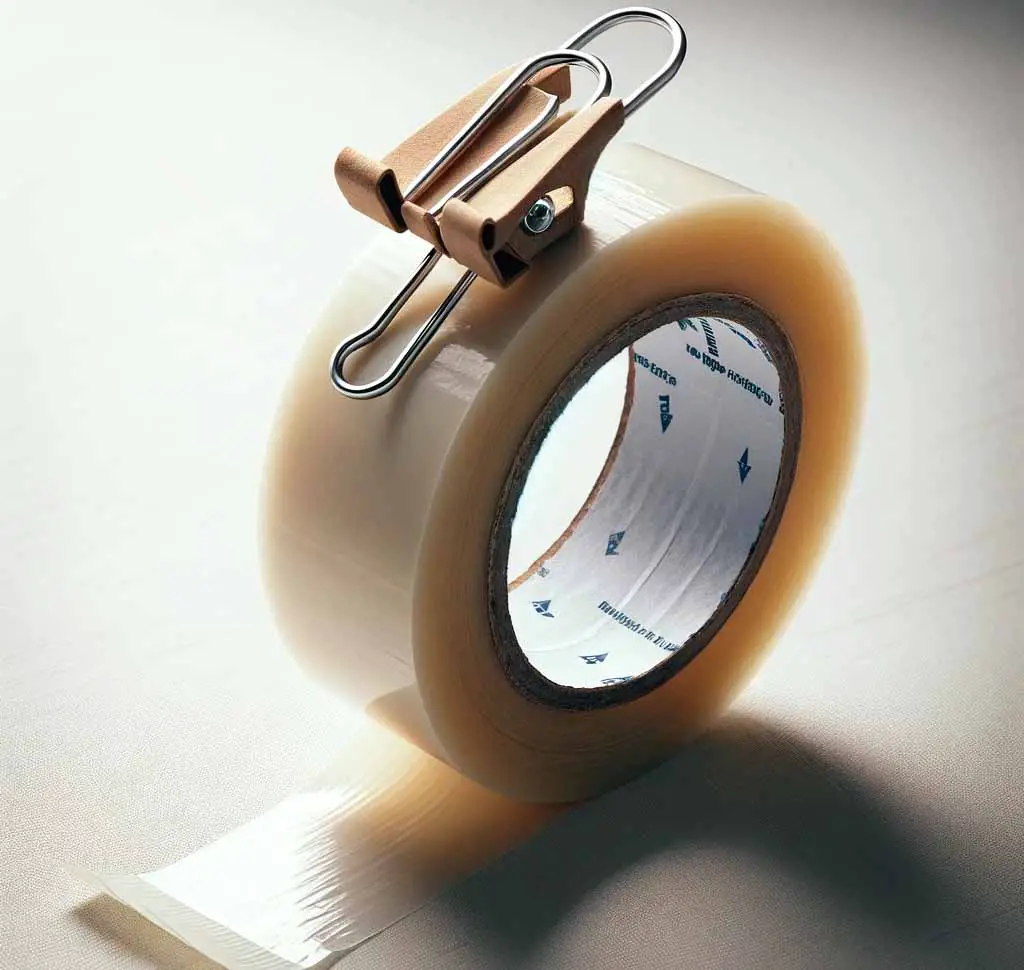
42.Borax for Pest Control:
Sprinkle borax in areas where pests are a problem.
Borax, a natural mineral, can be an effective and eco-friendly way to deal with household pests like ants and cockroaches. Mix equal parts of borax and sugar to attract pests. The sugar lures them in, while the borax acts as a poison to them. Sprinkle this mixture along areas where pests are a problem, like under sinks, along baseboards, or near entry points. Borax disrupts the pests’ digestive system, ultimately eliminating them. Remember to keep this mixture away from pets and children as it can be harmful if ingested.

43.Erasers for Wall Marks:
Remove marks from walls with a regular eraser.
Simple pencil erasers aren’t just for correcting writing mistakes; they can also be used to remove marks and scuffs from walls. Gently rub a clean eraser over the mark in a circular motion. The eraser will lift and remove the dirt or crayon without damaging the paint. This method works best on matte or flat-painted walls where traditional cleaners might leave streaks or cause discoloration.
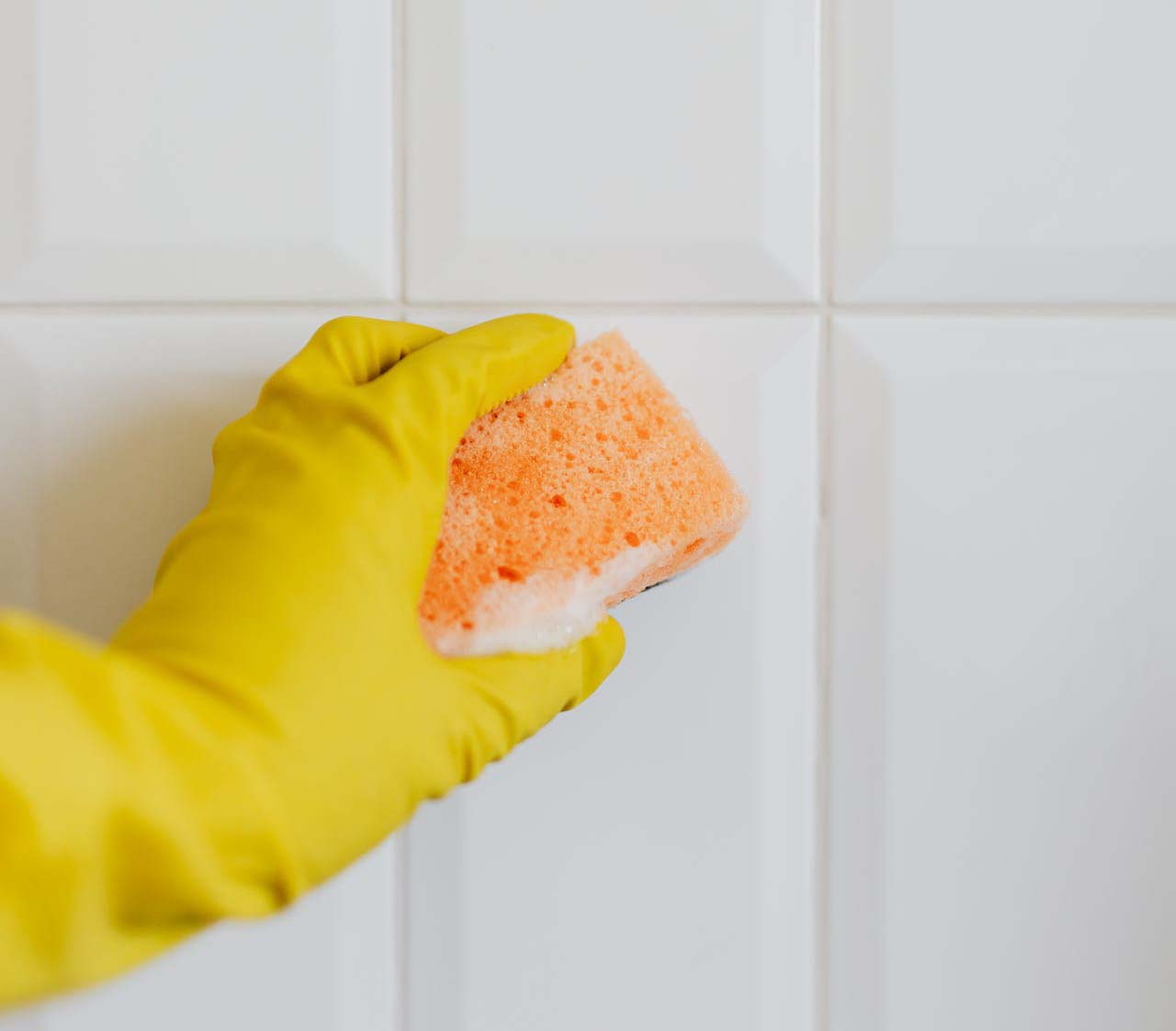
44.Shaving Cream for Mirrors:
Prevent fog on bathroom mirrors with shaving cream.
Shaving cream is not just for grooming; it can also be used to prevent your bathroom mirror from fogging up. Apply a small amount of shaving cream to the mirror and gently rub it over the entire surface with a clean cloth. Then, buff the mirror until it’s clear. This creates a thin protective layer that prevents the mirror from fogging during showers. It’s a simple, cost-effective solution that keeps your mirror clear and fog-free.
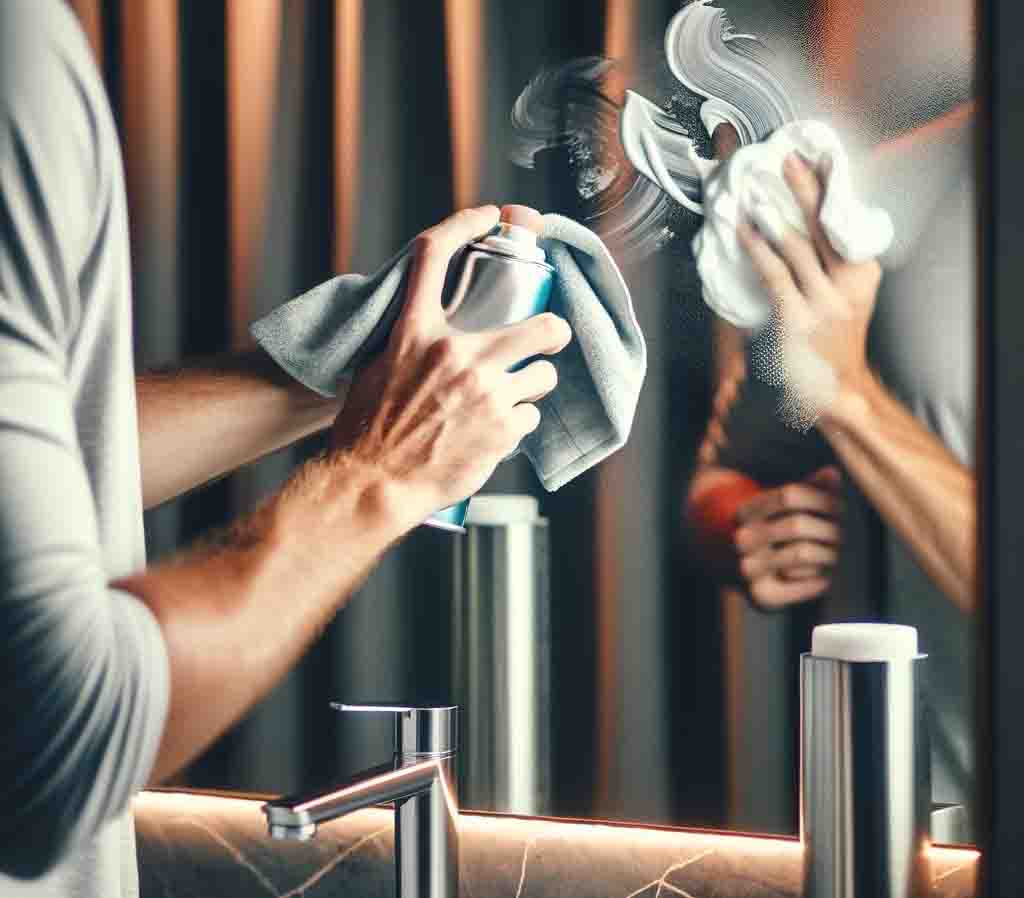
45.Frozen Sponge as an Ice Pack:
A frozen sponge in a ziplock bag works as a reusable ice pack and can clean spills in coolers.
A common household sponge can be turned into a reusable ice pack for coolers or lunch boxes. Soak a clean sponge in water, place it in a ziplock bag, and freeze it. The sponge will absorb and freeze the water, staying cold for an extended period. As it thaws, the sponge will reabsorb the water, preventing leaks. This is a great alternative to commercial ice packs, as it’s inexpensive and can be reused many times.
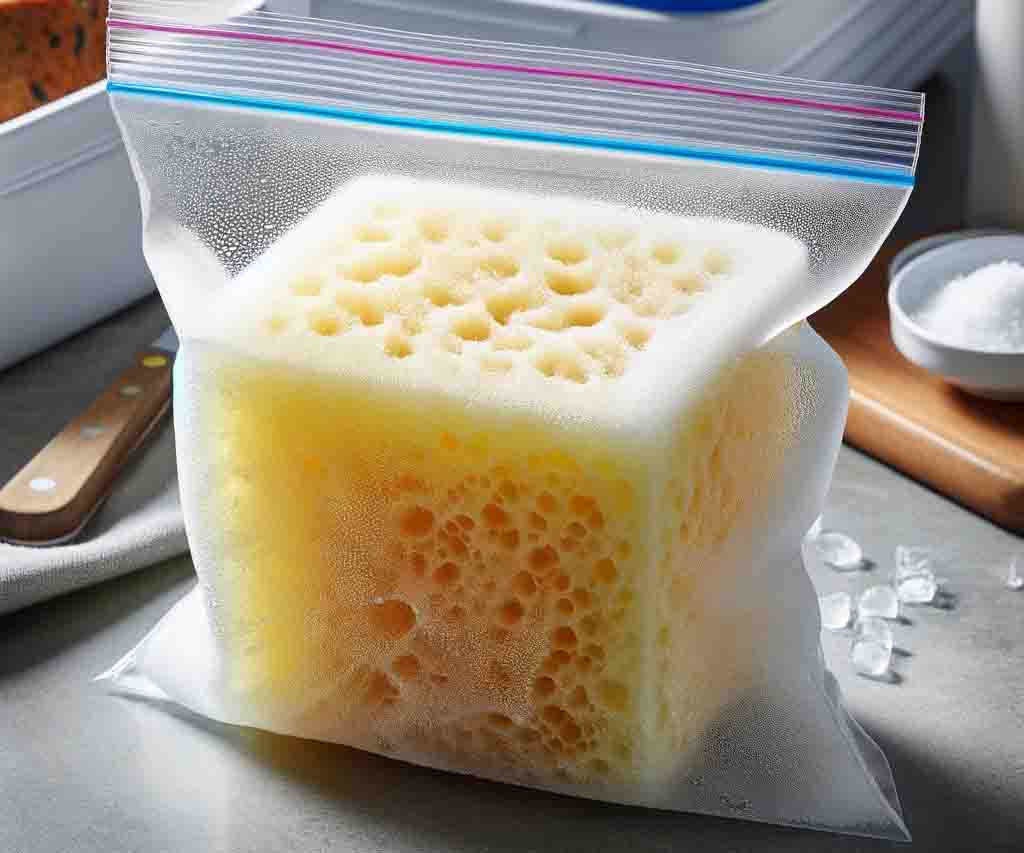
46.Rubber Band as a Door Stopper:
Wrap a rubber band around doorknobs to prevent locking yourself out while cleaning.
While cleaning, it’s common to move in and out of rooms frequently, and having doors close behind you can be inconvenient. A simple solution is to use a rubber band as a temporary door stopper. Stretch a large rubber band over the doorknobs on both sides of the door, crossing it over the latch. This prevents the door from latching shut, allowing for easy movement between rooms. This trick is particularly handy when you need to carry cleaning supplies or laundry from room to room.

47.Hair Conditioner for Stainless Steel:
A small amount of hair conditioner can polish stainless steel surfaces.
Believe it or not, hair conditioner can be used to polish stainless steel surfaces. Its moisturizing properties provide a surprising benefit in leaving a smooth, shiny finish on stainless steel. After cleaning the surface, apply a small amount of conditioner on a soft cloth and rub it into the steel. This creates a thin, protective layer that resists fingerprints and water marks. It’s an unconventional yet effective way to maintain the pristine appearance of stainless steel appliances and fixtures.

48.Tea Bags for Wood Surfaces:
Used tea bags can help clean and shine wood surfaces.
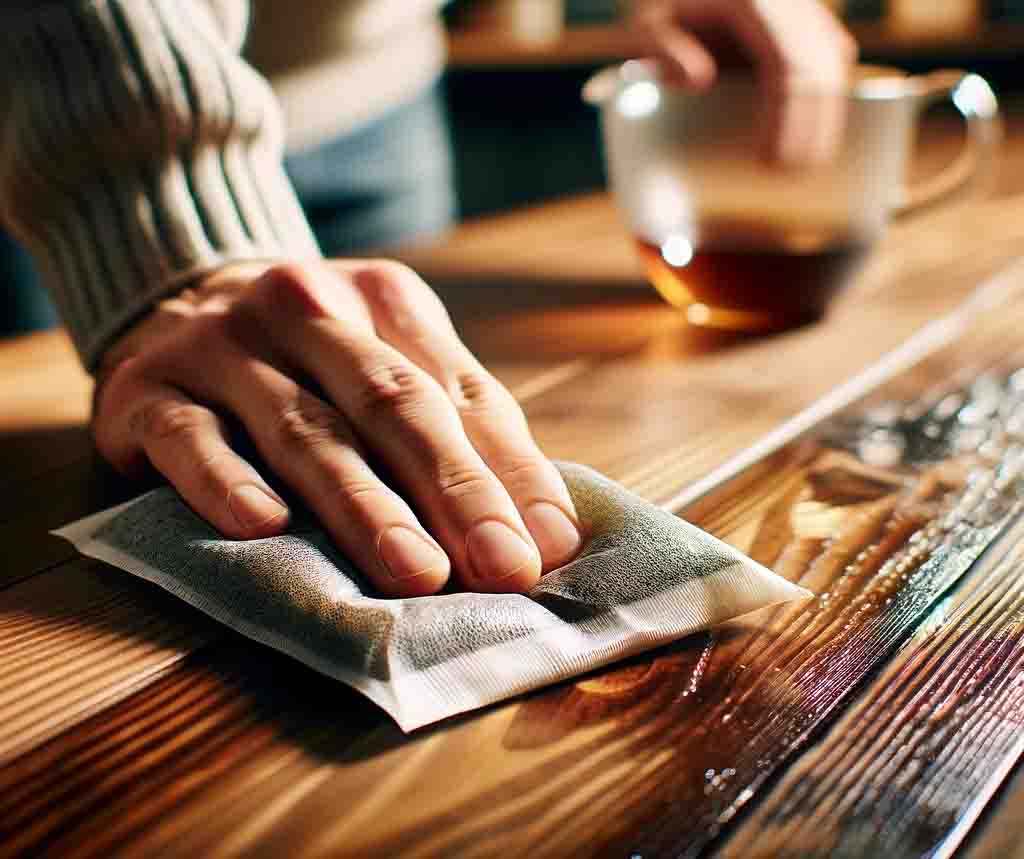
Used tea bags can serve a dual purpose by helping clean and shine wood surfaces. The tannic acid in black tea acts as a natural polish for wood. After brewing a cup of tea, let the tea bag cool and then gently wipe it over wood surfaces like cabinets, tables, or hardwood floors. This will leave a natural, subtle shine and help rejuvenate the wood. Plus, it’s an eco-friendly way to repurpose used tea bags.
49.Aluminum Foil for Scrubbing:
Ball up aluminum foil to scrub off tough residue.
Aluminum foil can be crumpled up and used as a makeshift scrubber. This is particularly effective for cleaning rust or grime off of metal surfaces, such as outdoor grills or baking racks. Roll a piece of aluminum foil into a ball and use it to scrub the affected area. The foil is abrasive enough to tackle tough grime, yet soft enough not to scratch most surfaces. Remember to use this tip with caution on delicate surfaces to avoid scratching.
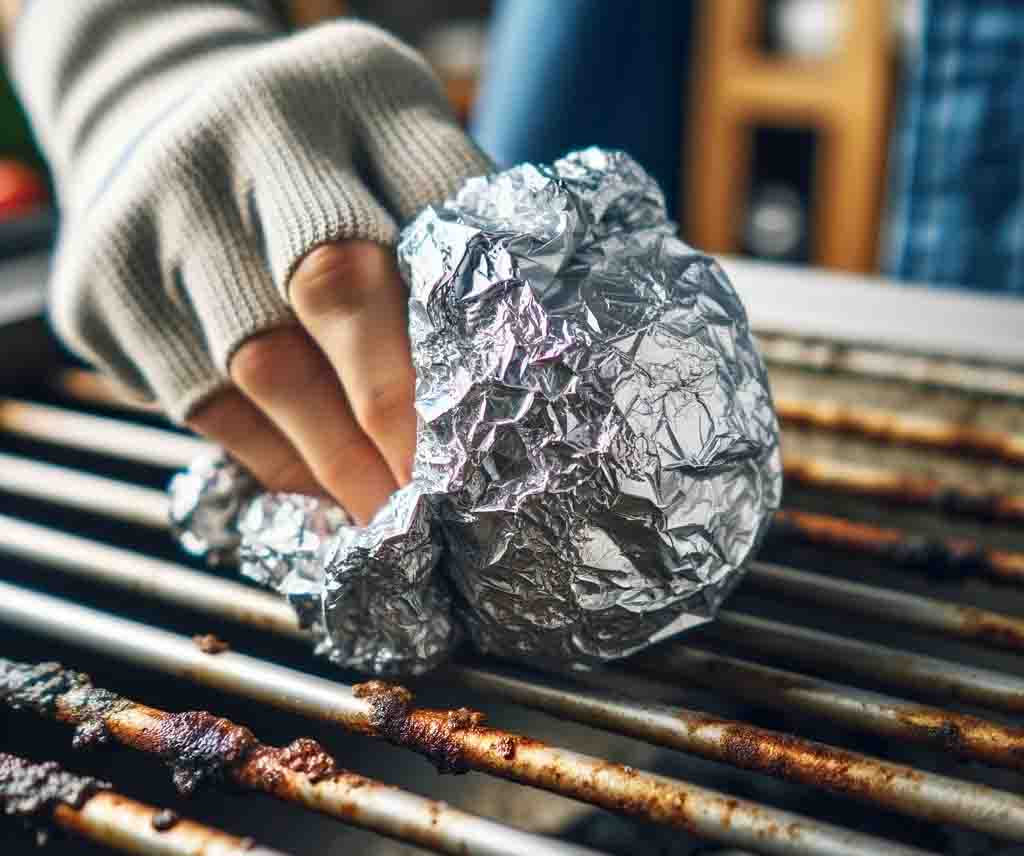
50.Essential Oils for Fresh Scent:
Add a few drops of your favorite essential oil to your cleaning solution for a pleasant aroma.
Adding a few drops of your favorite essential oil to your cleaning solutions can not only enhance the cleaning experience but also leave a pleasing aroma in your home. Whether it’s lemon for a fresh, citrusy scent or lavender for a calming effect, essential oils can elevate the ambiance of your space. Mix a few drops into your water-based cleaning solutions, or use them in a diffuser to help eliminate odors and create a welcoming environment.
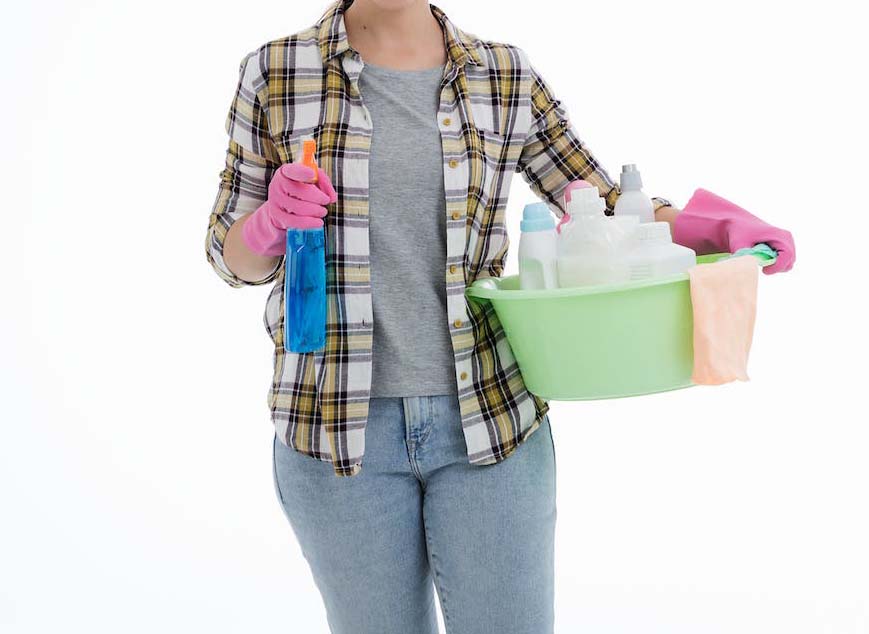

About The Author: Hi, I’m Jessica. I’m a Mom of 2 and I love DIY hacks, home decor ideas and non-toxic cleaning tips. I created this website to share my knowledge with a community of like-minded people who love simple, easy and safe ways to keep their home clean and inspiring. I hope you enjoy!

